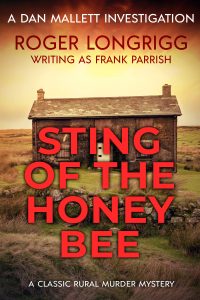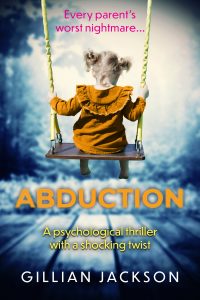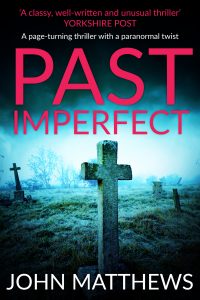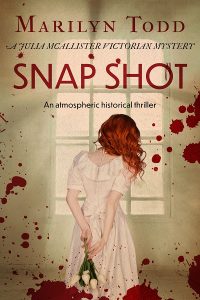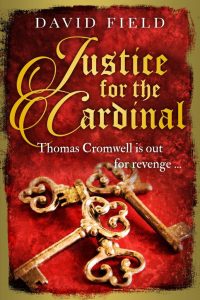Congratulations to David Field, whose twisty Victorian thriller, The Retirement Murder, is out now!
The Retirement Murder is the ninth instalment in the Esther and Jack Enright Mystery Series – a traditional British detective series set in Victorian London and packed full of suspense.
London, 1898
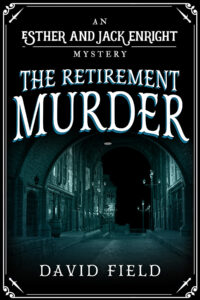
The time has finally come for Percy Enright to retire from Scotland Yard. His nephew, Jack, is sad to lose a partner in the force, but Jack’s wife Esther is glad Percy won’t be getting her husband into any further scrapes.
It seems Esther’s relief might be short lived, though, when a senior officer collapses at Percy’s farewell ceremony.
It soon becomes clear that the officer was poisoned, and Percy delays retirement to help Jack track down the culprit.
It’s a daunting task that involves trawling through all the murdered officer’s recent cases in the search for someone who may still bear him a grudge.
But when it becomes clear the dead man may not have been the intended target, the investigation suddenly turns in a new direction.
Why are the police being targeted? Can Percy make one final arrest before he retires?
Or will the murderer outwit the Enrights in their latest case…?
Following the success of his DS Hunter Kerr Investigations and Dr Hamlet Mottrell Investigations, we are delighted to announce that we have signed a new historical police procedural series by Michael Fowler.
In Michael’s words:
“My new series features Detective Winter Cooper of Scotland Yard and is set in the 1950s.
“Detective Cooper’s first case is based upon a real event, the Eastcastle Street robbery — Britain’s biggest cash-in-transit hold-up at the time. In May 1952, robbers used two cars to sandwich a Post Office van in London and escaped with mailbags containing £287,000 (estimated to be worth approximately £8,500,000 today). It was a case that shocked the nation and embarrassed the Government, with Prime Minister Winston Churchill demanding daily updates from the Police Commissioner. Despite the involvement of over a thousand police officers, and the offer of a £25,000 reward, no one was ever caught.
“This is my take on that case, and while it is a deviation from my contemporary novels, I hope readers will embrace Winter Cooper with the same enthusiasm that I have put into creating him and this new series.
“Working with Sapere Books again was an easy decision to make. Over the past five years, they have given me so much support as a writer and I cannot thank them enough. When I ran the idea of this new series past them, their backing was unflinching.”
Congratulations to C. V. Chauhan, whose heart-pounding thriller, The Right Time To Die, is out now!
The Right Time To Die is the third book in the Inspector Sharma Thriller series: gritty urban police procedurals set in Leicester.
DI Sharma is caught in a lethal race against time…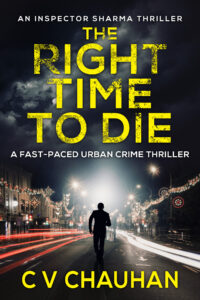
Tensions are running high in the city of Leicester. Recent conflict between groups of Hindu and Muslim youths has led to violence on the streets, which the police are struggling to control.
Despite these events, Sunil Kumar, a Bollywood superstar has been invited to switch on the lights along the Golden Mile for the festival of Diwali.
DI Rohan Sharma is one of the thousands of onlookers that have arrived to enjoy the celebrations.
But Sharma is aware of social media tip-offs that suggest the happy atmosphere could turn deadly…
And his suspicions seem to be confirmed when Sunil Kumar collapses on stage.
With the police chiefs mistakenly believing Sharma could have inside knowledge on the local hostilities, he takes the lead on the investigation.
But when a spate of killings occur, in seemingly unrelated circumstances, Sharma finds himself in over his head.
Sucked into a dark world of race hate and extremism, Sharma uncovers a deadly plot.
Can he stop more murders from occurring? Will he unmask the fanatical killers?
Or will a catastrophe engulf the city of Leicester…?
Congratulations to Graham Brack, whose absorbing crime thriller, The Murdered Molls, is published today!
The Murdered Molls is the seventh book in the Josef Slonský Investigations series, atmospheric police procedurals full of dark humour.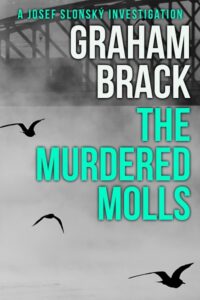
A woman is discovered brutally murdered in her apartment, with some of her body parts surgically removed.
The pathologist has dubbed the perpetrator the nastiest killer he’s ever come across in the Czech Republic.
But after a scuffle with a cat burglar, Captain Josef Slonský has found himself laid up in hospital with a series of torn ligaments in his knee, unable to rush to the scene of the crime.
With his medical review due in less than nine weeks, and the threat of enforced retirement hanging on the outcome, he is determined to get out of bed and back on active duty asap.
With the help of his friend Valentin, Slonský signs himself out of hospital and puts his mind to solving the killing.
Is a serial killer at large? Are more women in danger?
And can Slonský prove his worth and keep the job that means so much to him?
Congratulations to C V Chauhan, whose gritty urban thriller, Shattered Dreams, is published today! Shattered Dreams is the second book in the Inspector Sharma series.
When a body is found in Charnwood Forest in Leicestershire, Detective Inspector Rohan Sharma is called to the scene.
But before he can get there, a young woman arrives on his doorstep, saying she is scared for her life and asking for his help.
Before he can take down her details, she runs away.
And when Sharma reaches the crime scene, what he finds leaves him bewildered.
The prone body lying on the ground is of a man in full diving gear. He looks to have been dead for a while, but there is no obvious cause of death.
And before long, a second body is discovered, this time in the local river. It is a naked woman, with her head and hands missing.
Her build is similar to that of the mysterious woman on Sharma’s doorstep. But there is nothing to identify her.
Are the two deaths connected? Can Sharma and his team discover the identities of the two victims?
Or could they be about to unravel something even more disturbing…?
We are thrilled to be celebrating five years in business this month and we are incredibly grateful to all the writers, agents and literary estate holders who have helped us bring to market such a vibrant and diverse list of books.
Since launching Sapere Books in March 2018, our list has grown to include over six-hundred books by over one hundred authors. We have sold over 3 million books to date with 500 million pages read through Amazon’s Kindle Unlimited program.
In 2019, we employed our first full-time staff member, Natalie Linh Bolderston, who now holds the title of Assistant Editor, and in 2020, Matilda Richards and Helen Jennings both also joined our editorial team. They have all been essential to our ongoing success and we are over the moon that they are continuing the journey with us as we celebrate our first big milestone.
In 2020, we launched our non-fiction list, which includes classic works by authors such as E R Chamberlin, Sir Peter Gretton and John Bowle. And we are now pleased to announce that we are also hiring another staff member to help look after our burgeoning military history and military fiction list.
Since launching, we have focussed primarily on fiction, particularly historical fiction and crime fiction, and in 2021 we created our first historical writing contest, asking for entrants to submit a series outline loosely based on briefs we set. The response was so strong that as well as signing up five prize-winners we also signed ten more authors from the shortlisted entries.
We have always been keen to foster a community among our authors. In 2020, to combat some of the isolation due to the pandemic, we started running weekly Zooms for our authors to join and chat about their writing. These have become a valuable part of our ethos and we want to continue to make our authors feel welcomed, valued and part of the Sapere Books family.
We are also proud to announce that we have been certified Carbon Neutral since 2021 and we have created our own Sapere Books forest, planting a tree for every author that we work with.
We look forward to continuing to build strong relationships within the writing community and to publishing more brilliant genre fiction to capture the imagination of readers. Thank you again to everyone who has supported us and we hope you continue to love our books!
Amy, Richard and Caoimhe
Testimonials from four of the authors who launched with us in 2018:
David Field, author of the Medieval Saga series, the Tudor Saga series and many more
By one of life’s happy coincidences, I came across Amy Durant just when the publisher that had commissioned my first historical novel series decided to close down. Five years later I’ve published over twenty historical novels with Sapere, with ten more waiting to go.
When you become a member of the Sapere family, you’re all set for a rewarding writing career. If the quality’s right, you know that your latest ‘baby’ will be assured of a good home. They provide great editing, superb covers, expert marketing, regular royalty payments and guaranteed replies to your emails. Sapere authors have indeed been smiled upon by the patron saint of aspiring writers.
Keith Moray, author of the Inspector Torquil McKinnon series
Being published by Sapere Books has been a revelation for me as a writer. From the very first moment that Isabel Atherton, my agent at Creative Authors, arranged a chat with Amy Durant it has been a fabulous experience. Over the past five years, I have seen my backlist of fiction published along with five new novels, and I have three more under contract. Every aspect of book production from editing, cover design, publicity and marketing has been handled with flair and efficiency. On top of that, communication could not be easier or quicker, and Sapere Books have created a friendly atmosphere among all of the authors that makes me feel pleased to be part of the Sapere Books family. I could not be happier than I have been with Sapere Books, who are in my opinion without parallel in the publishing industry.
Linda Stratmann, author of The Early Casebook of Sherlock Holmes and the Mina Scarletti Mysteries
Becoming a Sapere Books author is like joining a warm and welcoming family, dedicated to providing the best for authors and readers. An experienced and hardworking team offers a soundly professional service, always on hand for support and advice. The last five years has seen Sapere grow and flourish, but never losing that personal touch.
Elizabeth Bailey, author of the Lady Fan Mystery series
Working with Sapere has been the most enjoyable and rewarding publishing experience in all my thirty-odd years as an author. That my career is flourishing is testament to the care and attention given to every book. Authors are encouraged to interact and support each other, which makes me feel part of a family, parented by the nurturing and talented Sapere team. Long may they reign! Oh, and we all love our covers!
Congratulations to C V Chauhan, whose page-turning serial killer thriller, The Dance of Death, is out now!
The Dance of Death is the first book in the Inspector Sharma Thriller series.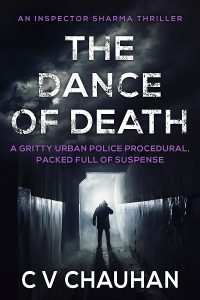
When a young Asian woman is found murdered in a particularly brutal fashion, the Leicestershire police force are put on high alert to find the killer.
The body was positioned in the shape of swastika and instantly points to racist motivations.
Newly promoted homicide detective Rohan Sharma is given the case – a surprise both to Sharma himself and his more experienced colleagues.
Desperate to prove himself, Sharma works around the clock – and soon discovers connections to the death of a young Somali woman that occurred the previous year.
But with his resentful colleagues working against him and his private life falling apart, Sharma struggles to keep his head in the game.
And when he starts to receive strange anonymous messages, he realises the killer may now be tracking his every move…
Can Detective Sharma stop the killer before he strikes again?
Or will he find himself trapped in a vicious dance of death…?
Congratulations to Michael Fowler, whose heart-pounding thriller, The Wedding Killer, is out now!
The Wedding Killer is the second book in the Hamlet Mottrell Investigations series.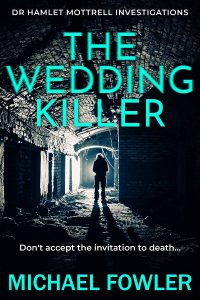
Having finally cleared his name after the brutal slaughter of his wife and unborn child, former forensic psychologist Dr Hamlet Mottrell is determined to piece his life back together.
He is given the opportunity to start a new career as a detective in a major investigation unit and is paired up with Detective Sergeant Alix Rainbow, the woman who once pursued him as the main suspect in his family’s murder.
Hamlet and Alix’s first case is a strange one.
A 21 year-old university student has vanished after a night out in Sheffield. And before she went missing, she received a wedding invitation from a stranger.
The pair soon discover that more female students are missing, each of them receiving the mysterious invitation.
Who is this shadowy stalker? Will the young women be found safely?
Or are Hamlet and Alix on the hunt for a serial killer…?
Sapere Books are proud to have sponsored the Crime Writers’ Association’s Historical Dagger Award, which is for the best historical crime novel set in any period at least 50 years prior to the year in which the prize is presented.
The 2021 shortlist featured domestic poisons, sinister former spies, military occupations and more.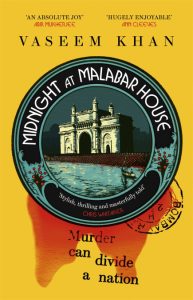
The wonderful Vaseem Khan has now been announced as this year’s winner. His winning novel, Midnight at Malabar House, is the first book in his latest historical crime series.
Compelling and cleverly plotted, Midnight at Malabar House opens on New Year’s Eve in Bombay, 1949. The first female detective in India, Persis Wadia has been repeatedly overlooked and struggles against a hostile, all-male environment. As a new decade dawns, she stands vigil in the basement of Malabar House, consigned to the midnight shift.
But when an English diplomat is murdered, Persis finds herself on the case of a lifetime. Against the backdrop of social and political turmoil, she teams up with Scotland Yard criminalist Archie Blackfinch to uncover the truth — at any cost…
We would like to send a huge congratulations to Vaseem, and to all of the wonderful authors who were longlisted and shortlisted this year.
Sapere Books are proud to be sponsoring the Crime Writers’ Association’s Historical Dagger Award, which is for the best historical crime novel set in any period at least 50 years prior to the year in which the prize is presented.
This year’s judges were Janet Laurence, the author of four cookery books and a series of articles on historical cookery; Angela May Rippon CBE, a television journalist, newsreader, writer and presenter; and Professor Edward James, Emeritus Professor of Medieval History at University College Dublin.
The 2021 longlist has now been announced. Many congratulations to the following authors and publishers:
Justice for Athena by J M Alvey, Canelo Digital Publishing Limited
Snow by John Banville, Faber
Midnight at Malabar House by Vaseem Khan, Hodder & Stoughton
Riviera Gold by Laurie R King, Allison & Busby
The Unwanted Dead by Chris Lloyd, Orion Fiction, The Orion Publishing Group
Execution by S J Parris, HarperFiction, HarperCollins
The Night of Shooting Stars by Ben Pastor, Bitter Lemon Press
The City Under Siege by Michael Russell, Constable, Little, Brown Book Group
Skelton’s Guide to Domestic Poisons by David S. Stafford, Allison & Busby
Chaos by A D Swanston, Bantam Press, Transworld
The Dead of Winter by Nicola Upson, Faber
The Mimosa Tree Mystery by Ovidia Yu, Constable, Little, Brown Book Group
We are delighted to announce that we have signed a new Leicester-based crime series by C V Chauhan.

C V Chauhan
The series follows Detective Rohan Sharma as he unravels a succession of dark and thrilling mysteries.
In C V Chauhan’s words:
“I’m absolutely delighted to have been signed by Amy and her team at Sapere for my new, three-book series which breaks new ground in the genre. I’ve been made most welcome by all members of the team and by my fellow authors. It’s a very friendly and supportive community, and I feel privileged to be part of it.
“If you like your crime fiction with added spice, then you’ve come to the right place. THE DANCE OF DEATH, my debut novel, introduces you to Rohan Sharma, an able, erudite detective who lives in the heart of the Asian community in Leicester and who has a talkative, African grey parrot for company. Recently divorced, he is the father of two children.
“In the first instalment in the series, Rohan Sharma and his team hunt for a psychopathic killer while dark forces undermine his work and put others in danger.
“THE DANCE OF DEATH will be published in the near future, and I’m currently working on the next Rohan Sharma novel. I’m not going to give away too much at the moment, but suffice to say it’ll have an international dimension. More on this later…”
Gaynor Torrance’s absorbing DI Jemima Huxley Thrillers follow a determined and resourceful female detective as she unravels gruesome crimes.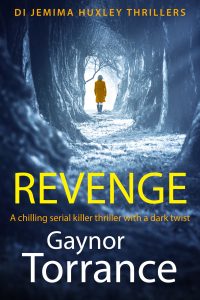
The first three books in the series, REVENGE, SOLE SURVIVOR and STALKED are already published. We are excited to announce that we have now signed up a further three instalments.
In Gaynor’s words:
“I am delighted to have signed with Sapere Books for a further three instalments of the DI Jemima Huxley Thriller series, as Jemima has many more cases heading her way. It really is a dream come true for me and I’m thrilled that Amy Durant – editorial director at Sapere Books – is keen for Jemima’s story to continue.
“GONE – the fourth book in the series – is due to go on pre-order soon. What starts out as the investigation into a young woman’s murder quickly evolves in some surprising ways. And in the inimitable Huxley style, I guarantee that the story is both dark and shocking. Jemima’s life will change forever when it takes an unexpected turn, and Broadbent has the chance to become a hero.”
Click here to find out more about the DI Jemima Huxley Thrillers
Michael Fowler’s DS Hunter Kerr novel, SHADOW OF THE BEAST features a horrific serial killer. Read on to find out more about where the inspiration for the Beast of Barnwell ― the murderer in this story ― comes from.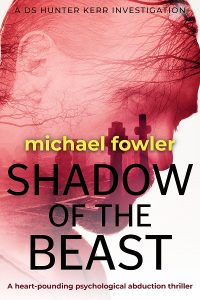
The ‘Beast’ is loosely based on Peter Pickering from Wombwell, near Barnsley, who was dubbed ‘the Beast of Wombwell’ by the press following his conviction in 1973 for the rape and murder of 14 year-old Shirley Ann Boldy, when he was jailed indefinitely.
Peter abducted Shirley Ann as she walked back to school at lunchtime, driving her to woods in the village of Barnburgh, where he tortured and raped her before stabbing her with a kitchen knife. Peter had to flee with her body in his van when he was disturbed by three men walking in the woods who tried to intervene after hearing her screams for help.
Arrested later that day, he had dumped Shirley Ann’s body, cleaned his van, burned his clothes and sandpapered and bleached his shoes in a hope of hiding evidence; however, he eventually confessed, blaming his mother for the killing, telling detectives that she would never allow him to have a girlfriend, and he could see her face as he killed Shirley.
The killing of Shirley Ann came just five months after he was released from prison after a six-year jail term for sex attacks on a teenage girl in Doncaster and Scarborough.
Detectives who dealt with Pickering firmly believed that Peter was responsible for more rapes and murders and were particularly interested in him for the unsolved murders of 13 year-old Anne Dunwell, from Rotherham, who was raped and strangled in 1964, and 14 year-old Elsie Frost from Wakefield, who was stabbed five times in 1965. He was visited several times while detained in Broadmoor by detectives and interviewed in connection with these murders, but he refused to cooperate.
However, in 2017, detectives had a breakthrough. Forensic evidence linked Peter to the murder of Elsie Frost and a fresh investigation was launched. During this re-investigation detectives discovered that Peter was renting a storage garage in Sheffield, and getting a warrant, they opened it up and found handcuffs, diaries and exercise books, which contained confessions. One of those confessions was the rape of an 18-year-old woman from Barnsley, which was undetected and after tracing the woman, who was then in her sixties, Peter was charged with that rape and convicted in 2018. Before he could be sentenced for that rape and also charged with the Elsie Frost murder, Peter died. He was 79.
Click here to order SHADOW OF THE BEAST
Click here to find out more about the DS Hunter Kerr Investigations
Each month, Sapere Books spotlights an author whose books have gone out of print and whose work we are republishing, in an effort to revive the most vibrant and engaging voices of the past.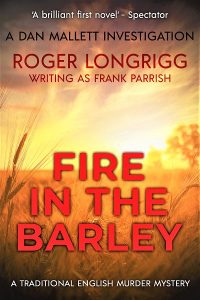
Born in 1929, Roger Longrigg was an impressively versatile author who wrote under several noms de plume. He used one of these – Frank Parrish – to pen the witty and suspenseful Dan Mallett Investigations, which Sapere Books is republishing. Set in the West Country of England in the 1970s, the cosy mystery series follows a crafty and likeable poacher as he unravels various crimes in the area – often committing several felonies himself in the process.
With its deft humour, clever plotting, and immersive rural setting, the first book in the series – Fire in the Barley – has been described by Roald Dahl as ‘exciting and funny from beginning to end’. The protagonist, Dan Mallett, has been praised as ‘a fully-fledged, all-of-a-piece original character in a well-conceived, excitingly paced story’ (The Times).
Roger’s daughter, Laura Longrigg, reflects on his life and career:
“Roger Longrigg worked in advertising in London in the early 60s; it’s also the setting of his first novel, A High-Pitched Buzz, full of the wild, clever, sexy, heavy drinking characters familiar from the cult TV series Mad Men of the same era.
“He dreamed of being a full-time writer but, despite receiving glowing reviews (including comparison to Evelyn Waugh), the book only earned him £100. His agent said, ‘You need to write three books a year to support the family, but not even Dick Francis fans want to read three of his in 12 months.’ So Roger wrote series of novels under different pseudonyms, eight in all. They include Laura Black: Scottish-based bodice-rippers; international espionage thrillers to emulate Ian Fleming under the name Ivor Drummond and psychological suspense by Domini Taylor, which included Mother Love, turned into an award-winning TV drama starring Diana Rigg. Perhaps most successful was Frank Parrish, creator of poacher turned detective Dan Mallett; the first in this series, Fire in the Barley, won the John Creasey Dagger in 1977 for best first novel. Roger had to turn it down, because it was actually his 26th!
“In all, Roger wrote 55 books of fiction and non-fiction; he thoroughly enjoyed the subterfuge of being behind so many different personalities and genres and it’s thrilling that he is about to find a whole new generation of readers through Sapere’s reissues, and that his real name can be revealed at last.”
Click here to order Fire in the Barley
Click here to find out more about the Dan Mallett Investigations
We recently had a digital meet-up with some of our authors to catch up on current projects and find out how lockdown has impacted their writing. Read on to find out more about their creative news and practices:
Elizabeth Bailey has published six Lady Fan Mysteries, four Brides By Chance Regency Adventures, and two more historical romances. She is working on her seventh Lady Fan book. Elizabeth has also been taking daily walks, giving digital readings, and maintaining her weekly newsletter, which is filled with writing updates and giveaways.
Graham Brack has published six Josef Slonský Investigations and two Master Mercurius Mysteries. He is working on the next books in both series. Graham finds that working on two series simultaneously helps prevent him developing writers’ block with either one.
Jane Cable has published one contemporary romantic saga drawing on World War II, and her second – Endless Skies – is forthcoming. Jane has been developing a new website, editing Endless Skies, and working on a new contemporary romance novel.
Tim Chant has a Russian-Japanese naval novel forthcoming and has started the next one. He is also writing and self-publishing science-fiction and steampunk novellas.
 Michael Fowler has published five DS Hunter Kerr Investigations. He is currently working on a new series, developing a character who is a forensic psychologist. As part of this, Michael is researching various forensic technologies and has spoken to an expert in the field.
Michael Fowler has published five DS Hunter Kerr Investigations. He is currently working on a new series, developing a character who is a forensic psychologist. As part of this, Michael is researching various forensic technologies and has spoken to an expert in the field.
Justin Fox has two nautical novels forthcoming with Sapere Books. These are also being published in South Africa by Penguin Random House and are currently being edited.
Anthony Galvin (who also writes as Dean Carson) is the author of historical non-fiction book Death and Destruction on the Thames in London. He is working on a series of thrillers. As a mature student, Anthony has also been finishing up assignments and exams.
Sean Gibbons’ gritty crime series – following taxi driver Ben Miller – will be published in 2021. He is currently writing the fourth book in the series and has just finished a World War II espionage thriller.
Gillian Jackson has published three psychological thrillers. She is now editing old and self-published work, finding ways to re-purpose old characters. Gillian is particularly interested in developing more contemporary women’s fiction with a psychological element.
Natalie Kleinman has four Regency romances signed up and has written two more. She has recently made a start on a new romantic novel.
Simon Michael has published five Charles Holborne Legal Thrillers, and he has a sixth one lined up. Aside from writing, he has recently been busy with building work.
Ros Rendle has six romance novels forthcoming with Sapere Books, including her Strong Sisters trilogy. Ros has recently finished a new novel, and she has found her Chapter writing group (regional groups of romance writers affiliated with the Romantic Novelists Association) a great source of support.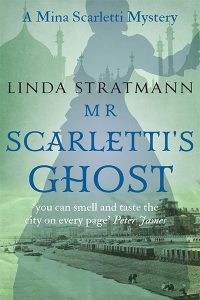
Linda Stratmann has published five Mina Scarletti Mysteries and is writing the sixth. To help with this, she has been researching Victorian spirit photography using Archive.org. Linda has also been gardening, cooking, baking, and holding digital meetings with the Crime Writers’ Association, of which she is the chair.
Deborah Swift has published two romantic World War II sagas and is working on the third, which will be set in Shetland and Norway. She has been researching nautical terminology and walking a lot, which she finds is a great time to think about plot.
Alexandra Walsh has published three timeshift conspiracy thrillers; the last one, The Arbella Stuart Conspiracy, came out in May. She is now writing a Victorian dual-timeline novel and is planning to start a newsletter.

Sapere Books are proud to be sponsoring the Crime Writers’ Association’s Historical Dagger Award, which is for the best historical crime novel set in any period at least 50 years prior to the year in which the prize is presented.
This year’s judges were Janet Laurence, the author of four cookery books and a series of articles on historical cookery; Angela May Rippon CBE, a television journalist, newsreader, writer and presenter; Professor Edward James, Emeritus Professor of Medieval History at University College Dublin; and Andre Paine, former editor of Crime Scene magazine.
The 2020 longlist has now been announced. Congratulations to the following authors and publishers:
THE MAN THAT GOT AWAY by Lynne Truss, Raven Books
THE KING’S EVIL by Andrew Taylor, Harper Collins
THE BEAR PIT by SG MacLean, Quercus Fiction
THE ANARCHISTS’ CLUB by Alex Reeve, Raven Books
METROPOLIS by Philip Kerr, Quercus Fiction
THE PAPER BARK TREE MYSTERY by Ovidia Yu, Constable
THE SERPENT’S MARK by SW Perry, Corvus
IN TWO MINDS by Alis Hawkins, The Dome Press
LIBERATION SQUARE by Gareth Rubin, Michael Joseph
THE BONE FIRE by SD Sykes, Hodder & Stoughton
SORRY FOR THE DEAD by Nicola Upson, Faber & Faber
DEATH IN THE EAST by Abir Mukherjee, Harvill Secker
Linda Stratmann is the author of the MINA SCARLETTI INVESTIGATIONS, a traditional British detective series set in Victorian Brighton.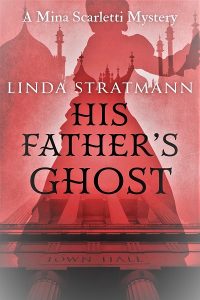
More than a year ago, I determined to write a book in which Mina Scarletti, disabled by the scoliosis that twists her spine and cramps her lungs, is taken ill and solves a mystery while confined to bed. It is not a new concept. In The Wench is Dead, Inspector Morse solves a Victorian murder while in hospital, and in Josephine Tey’s The Daughter of Time, Inspector Alan Grant, hospitalised with a broken leg, explores the fate of the Princes in the Tower.
But these are historical puzzles, and therefore considered suitable to engage the mind of a bored invalid. In His Father’s Ghost, Mina has additional challenges. She is intrigued by a current conundrum, the disappearance of a local man while out sailing, declared legally dead, but his actual fate unknown. Her doctor, however, has advised her against any activity that might tax her delicate health, and that includes solving mysteries. She has to use all her ingenuity to gather the information she needs. In doing so, she finds that she has uncovered evidence of past crimes and scandals. Her enquiries are a catalyst that set off a train of events that ultimately have dramatic and life-changing consequences for several prominent citizens of Brighton.
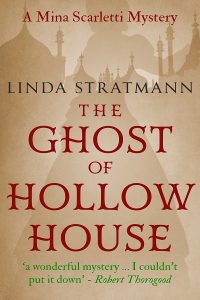 One of the themes which I explore in this book is hallucination. Mina, when stricken by a fever, sees and hears things that reveal what is troubling her. The son of the vanished man, disturbed by significant events, has terrifying visions in those dark hours that lie between sleeping and waking.
One of the themes which I explore in this book is hallucination. Mina, when stricken by a fever, sees and hears things that reveal what is troubling her. The son of the vanished man, disturbed by significant events, has terrifying visions in those dark hours that lie between sleeping and waking.
I really enjoyed my research for this book. I visited the fascinating Police Cells Museum of Brighton, and read about the curious spiritoscope, an apparatus designed to prove that it was spirits and not the medium who cause the movement of the divination table.
It was my real pleasure to include two characters who have appeared in previous books, the flamboyant actor Marcus Merridew, fresh from his acclaimed season as Hamlet, and the creepy young photographer Mr Beckler.
While editing the manuscript, which was completed at the end of 2019, I was struck by how Mina’s plight echoes our current time. She is ill with a lung infection, and effectively on lockdown. But when she scents a puzzle, it gives her strength. She needs not only warmth and air and nourishment, but material to keep her busy mind alive.
Click here to pre-order HIS FATHER’S GHOST
To help keep you entertained during quarantine we’ve put together a list of some of our most absorbing thrillers, featuring mysterious disappearances, historical conspiracies, ghostly dreams and more…
A compelling timeshift mystery, Paternoster moves between 18th Century and modern-day England. In 1795, kept woman Rachel Lovett is left homeless and destitute when her benefactor loses his money. Forced to steal jewellery to survive, Rachel finds herself constantly on the run from the law and the hangman’s noose. And when she joins a brothel, she is soon introduced into the ruthless Paternoster Club…
In 2013, Private Investigator Eden Grey is called in to examine a pair of skeletons found in the grounds of a prestigious school. It soon becomes obvious that these are not recent murders – the bodies have been buried for centuries. And now Eden must unravel a historic mystery while concealing her own personal demons…
Click here to order Paternoster
 The Black and the White, Alis Hawkins
The Black and the White, Alis Hawkins
Set in 1349, The Black and the White is a chilling medieval mystery that explores the ravages of the infamous Black Death. Martin Collyer wakes up in his family’s charcoaling hut, having made a miraculous recovery. But his father, who showed no signs of the plague, is dead.
With no home to go to, Martin seizes his second chance at life and goes on a journey to seek salvation for his father’s unconfessed soul. Along the way, he befriends another traveller, the enigmatic Hob Cleve. But when more suspicious deaths occur, Martin begins to wonder whether he is travelling with a killer…
Click here to order The Black and the White
Abduction is an emotional psychological thriller that confronts every parent’s worst nightmare. During her third birthday party, little Grace disappears without a trace while playing a game of hide and seek.
As the years go by and the case goes cold, Grace’s parents lose hope of ever finding her and do their best to move on with their lives. But her older sister, Elise, refuses to give up. And a chance encounter leads her to believe that she may have found her…
Spanning three decades, Past Imperfect is a gripping international crime novel with a paranormal twist. In 1963, a boy is kidnapped and murdered in the French countryside. The killer is seemingly caught, but young policeman Dominic Fornier is convinced he is innocent.
In London thirty years later, a boy loses his parents in a car accident and is left comatose. And when he regains consciousness, he is plagued by eerie dreams of a life that isn’t his. When Fornier hears of a possible link between the two boys, he throws himself into a desperate race against time to catch a brutal killer and right the wrongs of the past…
Click here to order Past Imperfect
The Catherine Howard Conspiracy, Alexandra Walsh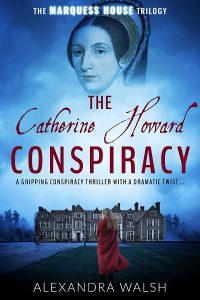
The Catherine Howard Conspiracy is an absorbing dual timeline conspiracy thriller with a shocking twist on Tudor history. In 1539, young Catherine Howard is brought to the court of King Henry VIII to be a lady in waiting to the new queen, Ann of Cleves. But when she catches the king’s eye, her uncle begins scheming to secure a Howard heir to the throne. After the fate that befell her cousin, Anne Boleyn, Catherine is terrified of the unpredictable king and begins to fear for her life.
In 2018, Perdita and Piper Rivers inherit Marquess House from their estranged grandmother, renowned Tudor historian Mary Fitzroy. When Perdita sets out to uncover Mary’s reasons for abandoning them, she is drawn into the mysterious archives of Marquess House: a collection of letters and diaries that claim all records of Catherine Howard’s execution were falsified…
Click here to order The Catherine Howard Conspiracy
Like the look of these thrilling reads? Sign up to the Sapere Books newsletter for new releases and deals in crime and thriller fiction.
Sapere Books has reached its second birthday!
We now have a family of over 50 authors and plenty of chart successes under our belt.
To celebrate our first two years as a company, we threw a party in London and caught up with our fabulous authors over drinks and nibbles. All have exciting new projects brewing. Here is a taster of what to expect from our authors in 2020.

Alexandra Walsh and Graham Brack
Graham Brack is working on a historical fiction series, the Master Mercurius Mysteries, set in the 17th century. The first book, Death in Delft is already available to pre-order, and more will follow later this year.
Keith Moray has written the Sandal Castle Medieval Thriller series, historical murder mysteries set in Yorkshire. The first book, The Pardoner’s Crime, is available to pre-order, and more are soon to follow.
Alis Hawkins’ brand-new Medieval novel The Black and The White will be published later this month.
David Field is working on a brand-new Victorian mystery series, the Carlyle & West Mysteries, which will launch very soon.
Jane Cable has another thought-provoking romance with echoes of the past launching soon.

Stephen Taylor, Caoimhe O’Brien, and Keith Moray
Gillian Jackson has written a new psychological thriller, which will be released this summer.
Natalie Kleinman will be joining our excellent Regency Romance authors with her sparkling new books, which will feature strong and resourceful heroines.
Ros Rendle will be launching her Strong Sisters series this year – sweeping sagas that will explore family relationships and rivalries.
Seán Gibbons’ gritty urban crime series set in Galway will launch later this year.
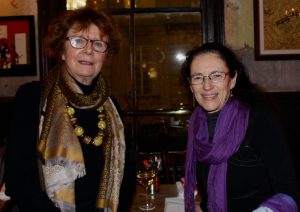
J. C. Briggs and Linda Stratmann
Stephen Taylor has a series of 18th century novels coming out soon.
And there are new books coming out soon from fan-favourite series, such as Alexandra Walsh’s Marquess House Trilogy, Elizabeth Bailey’s Lady Fan series, J C Briggs’ Charles Dickens Investigations series, Gaynor Torrance’s DI Jemima Huxley series, Charlie Garratt’s Inspector Given series, Michael Fowler’s DS Hunter Kerr series, Valerie Holmes’ Yorkshire Saga series, Marilyn Todd’s Julia McAllister series, Simon Michael’s Charles Holborne series, John Matthews’ Jameson & Argenti series and Linda Stratmann’s Mina Scarletti series.
For more information on our latest releases and ebook deals sign up to the Sapere Books newsletter.
To celebrate International Women’s Day (8th March) we asked five of our authors to tell us all about their favourite female writers. Read on to find out more about their literary heroines!
Alis Hawkins, author of The Black and the White and Testament
My all-time favourite author is Joanna Trollope. An odd choice for a crime author? Not at all. Wonderful writing transcends genre, and she inspires me by drawing characters with a fine eye to dialogue and interaction; by bringing whole scenes to life with a few telling details; by making her readers care passionately about what happens to her characters.
Joanna Trollope has shown me how essential it is to do your research meticulously, to immerse your readers in the world you’re writing about – whether it’s a cathedral close or a dairy farm, a ceramics factory or a Spanish vineyard – but never to include a single unnecessary fact that might slow the action down.
Each Joanna Trollope novel begins with a single key event that turns the lives of all her interrelated characters upside down – and what else does a murder at the beginning of a book do but that?
Order THE BLACK AND THE WHITE here
M. J. Logue, author of the Thomazine and Major Russell Thrillers
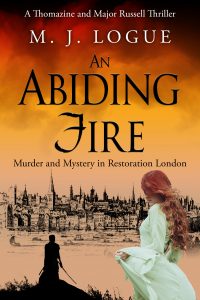 My busy little mind raced over all the possibilities – Tanith Lee, Storm Constantine, Dorothy Dunnett, Helen Hollick … but there can be only one, for me. Aphra Behn, of course. It’s not the what or the how of her writing, but the enigma and the old-school glamour of the writing persona she created – the international woman of mystery, the myths with which she surrounded herself – that inspires me. (Three hundred and fifty years later, she’s still a mystery!)
My busy little mind raced over all the possibilities – Tanith Lee, Storm Constantine, Dorothy Dunnett, Helen Hollick … but there can be only one, for me. Aphra Behn, of course. It’s not the what or the how of her writing, but the enigma and the old-school glamour of the writing persona she created – the international woman of mystery, the myths with which she surrounded herself – that inspires me. (Three hundred and fifty years later, she’s still a mystery!)
She was the first female literary professional, she did all her own publicity, and she’s still incredible. Possibly a spy, possibly bisexual – both, I suspect, images she manipulated to the hilt – and definitely a woman who knew how to work an audience. The fact that her plays and poems still resonate with us now is remarkable. She created characters that speak to us, no matter what clothes they’re wearing.
Or find out more about the Thomazine and Major Russell Thrillers here
Deborah Swift, author of Past Encounters and The Occupation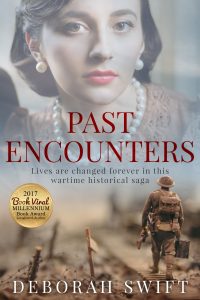
The first Rosie Tremain novel I read was Music and Silence, set in the Danish court in the early 17th Century. Marvellously atmospheric, it shifts between different narrative styles: small vignettes that add up to a magnified version of life in Copenhagen that is so real, you feel you are there.
I’ve read all her other books since, including the more contemporary The Road Home, about an economic migrant arriving in the UK, who observes with bafflement the English obsession with status and success. I admire Tremain’s precision, and that is something I want to achieve in my own writing.
Gaynor Torrance, author of the DI Jemima Huxley Thrillers
 I write in the genre I love to read, and being an avid reader of crime fiction, there are so many female authors whose work I admire. A particular favourite of mine is Sophie Hannah. I first stumbled across her books by chance, when I borrowed a copy of Little Face from my local library. Once I started reading, I couldn’t put it down.
I write in the genre I love to read, and being an avid reader of crime fiction, there are so many female authors whose work I admire. A particular favourite of mine is Sophie Hannah. I first stumbled across her books by chance, when I borrowed a copy of Little Face from my local library. Once I started reading, I couldn’t put it down.
Since finishing that particular book, I’ve worked my way through much of the Culver Valley Crime series. I adore the originality and complexity of Sophie’s plots, which have lashings of intrigue and misdirection. The central characters, DS Charlie Zailer and DC Simon Waterhouse, are such a great pairing. They’re both so dysfunctional and vulnerable in many ways, yet somehow form a compelling and likeable team.
Or find out more about the DI Jemima Huxley Thrillers here
Alexandra Walsh, author of The Marquess House Trilogy
She may be old-fashioned, and her comments can make me wince, but take away the occasionally dubious contents of a bygone era and Enid Blyton remains a huge inspiration with the breadth of her storytelling skill. In her adventure books, her plotting is deft and sharp, while in her fantasy books her imagination is broad and tantalising.
As a child, she shaped my reading habits but my eureka moment came when I was reading In the Fifth at Malory Towers. I was already harbouring ambitions to be a writer, but it was only a dream. Then, the heroine of the series, Darrell Rivers, wrote the school pantomime. Suddenly, I thought, If Darrell can do it, then so can I! My life path was set. From reading Enid Blyton’s work, I learned that girls were stronger and more effective if they worked together, that girls could do as much as boys and usually more, and that if you were determined you could solve anything – lessons that still resonate today.
Order THE CATHERINE HOWARD CONSPIRACY here
Or find out more about The Marquess House Trilogy here
DAY ONE
6 July 2008
She bucked and jerked wildly and he had to bear down all of his twelve stone onto her wiry yet well-toned young body as her limbs smacked against his… She was fighting for her life.
Then the air exploded from her chest in a heavy moan and she stopped thrashing.
Gasping for breath and drenched in sweat, he pushed himself up from her limp figure. He’d thought she was never going to die, amazed at the fight she had put up. He took several deep breaths and tried to slow his racing heartbeat, watching with fascination as dark viscous blood belched from her eye sockets, joining other rivulets which were already matting her dark bob of hair and forming a pool around her head.
Bending down, he scraped the mess from his knife into the dusty earth and then dropped it into his coat pocket and set to work.
He couldn’t leave her body here.
Dragging the bloodied corpse by the wrists along the flagstone floor, he soon found himself gasping for breath again, and he could feel fresh beads of sweat tickling his ribcage as he hauled her towards the barn entrance.
Then a distant unfamiliar noise caught his attention; a noise which didn’t belong to the surroundings. He paused and listened. It was coming nearer. He dropped the girl’s arms and dashed to a slit in the barn wall, threw himself against the damp stone and twisted sideways to peer through the gap without being seen. For a split-second the sunlight blurred his vision but as it cleared, he spotted a flat-back lorry bouncing along the uneven farm track, coming his way.
He closed his eyes and held his breath, gritting his teeth. He couldn’t believe his bad luck. He had sought out this place especially for its remoteness, visiting it at different times over the past few weeks to finalise his plan. In all that time no one had come near and now, today of all days, he had a visitor. For a few seconds he thought about killing the driver, but then realised he didn’t know this adversary.
He looked back along the lane. The truck was only a few hundred yards away and there was no sign of it stopping.
He took one last look at the lifeless form, realising he had no other choice but to make his escape, leaving behind this bloodied mess. He couldn’t afford to be caught. Not after all this time.
‘Damn,’ he cursed, realising he wouldn’t be able to finish off what he had set out to do. He slipped the playing card from his trouser pocket and, suit side up, placed it over the gaping wound in the middle of her chest. Now was the time to show them that this was his handiwork.
Dennis O’Brian swung the Bedford lorry through the broken entranceway that led to the tumbledown farm and braked sharply, throwing up a cloud of dust. Surveying the old Yorkshire stone buildings in a bad state of repair, he smiled to himself. Then, making a quick call on his mobile, he shut down the engine, flung open the driver’s door and leapt out of the cab. For a good few seconds he scanned the ramshackle buildings, weighing up which portions of stone would reap the most rewards.
Then he froze and his heart skipped a beat as he caught the sound of running feet. He was about to leap back into his truck when he realised the footfalls were growing fainter. Whoever had been here was legging–it, he thought. A grin snaked across his mouth and he chuckled to himself. Bet it was another stone thief who thought he was going to be caught.
As he stepped out of the sunlight into the dimness of the barn’s interior, he wasn’t prepared for what greeted him. Sprawled across the uneven dirt floor was a lifeless and bloody form. Only from the clothing could he tell it was a girl; the injuries inflicted upon her were like nothing he had ever seen before.
He began to retch as he fished in his jeans pocket for his mobile.
As he pushed the CID car door shut with his hip, Detective Sergeant Hunter Kerr paused for a moment and gathered his thoughts while casting his gaze out over the very active crime scene before him. He watched a line of uniformed officers, regular intervals apart, striding slowly through waist-high crops, their white short-sleeved shirts standing out against a backdrop of lush green trees.
Above him the Force helicopter hovered, the drumming noise of its rotor blades disturbing the peace of the surroundings.
He had raced here at breakneck speeds, listening to updates being broadcast over his radio. By the time he arrived, he had enough information to formulate a picture in his mind of what had happened.
Scanning the surroundings with his steel blue eyes, he knew that in one of the dilapidated and derelict farm buildings ahead a young girl’s battered body had been found, and that her killer had fled the area only about an hour beforehand. Right now, everything was being done as quickly and thoroughly as possible to track down her murderer and secure the site.
Hunter knew this area well. As an amateur artist, he had visited the location on many occasions and painted the subjects in the vicinity. In fact, the old farm buildings had been captured many times in his oil sketches. It was disconcerting that such atmospheric surroundings, which featured in paintings back home, were now centre-stage in a gruesome discovery.
‘Hi Sarge.’
Hunter turned to see his partner DC Grace Marshall tramping towards him at a pace. In her smart, pale grey business suit, Grace looked more the confident professional businesswoman than a hard-working front-line murder detective.
She was corralling her dark hair into an elastic scrunchy. Her face was grim.
‘It’s bad in there, Hunter. You ought to see what he’s done to her.’
‘What have we got then, Grace?’
‘It looks like it’s Rebecca Morris, the fourteen-year-old who was reported missing only a few hours ago. She should have turned up for an exam at her school this morning but didn’t.’ Grace finished bunching her hair. ‘She’s in a real mess. Her face is barely recognisable. No one’s moved or touched the body. First uniform on site could see from the state of her that she was dead and immediately cordoned off the area. The three nines call came from a guy who had driven here in his lorry. He’s now back at the station being interviewed. His story is that he just happened to be driving up the track to the farm for a quick ten minutes rest, but he’s got form for theft and it’s my guess that he was going to nick some of the stone or slates from here. Anyway, he says he just got out of his cab, heard the sound of someone running from the back of one of the buildings, and then a car starting up and screeching away. When he goes round to look, he finds the girl dead in the barn.’
‘And do we believe him?’
Grace shrugged her shoulders. ‘No reason not to at the moment. As I say, he is known to us. He’s got previous for nicking stone and lead from church roofs. He’s also got a couple of convictions for drunk and disorderly, but those are over fifteen years ago, and he’s got nothing for violence. And to be fair, he did ring it in and stick around until uniform arrived, and they say he appeared to be genuinely shook up over it. I’ve had him lodged in a cell and he can stew there for a couple of hours ’til we’re clear from here. I’ll get a statement from him and then kick him out.’
‘Any description of the person he disturbed?’ Hunter asked.
‘No, unfortunately not. Well gone before he got to the barn. The guy says he heard a car or van driving off up the dirt track over there.’ Grace pointed to a small copse of trees several hundred yards away.
It was warmer than he’d anticipated and Hunter tugged at the crisp collar of his blue shirt. Before he had shot away from the station he had slung on a jacket. Now he wished he hadn’t and he undid the top button of his shirt and loosened his tie.
‘Where does that track go to, Grace?’ he asked, pointing at a line of bushes just beyond the old farm buildings.
‘It leads up to a B road half a mile away. It takes you past the Ings and eventually brings you out near the village of Harlington. I’ve got uniform to seal off that area as well.’
‘Okay, good job, Grace. Are Scenes of Crime here?’
‘Just arrived. The forensic pathologist and the senior investigating officer are also en route. Everything should be in place in the next hour.’
Hunter realised it was an ideal opportunity to slip off his jacket and make the most of the warm breeze drifting across the fields. Going to the rear of his CID car he sprang open the boot and dropped his coat into the back. Then, pulling the sides of his shirt from his sticky and clammy skin, he reached into one of the storage boxes and pulled out a white forensic suit and set of shoe covers. He handed these to Grace and then pulled out another set for himself.
‘Come on then, show me what we’ve got,’ he said as he stepped into one leg of the protective suit.
Having satisfied themselves that all the relevant evidence sites were secured, Hunter and Grace made their way back to the murder scene, carefully following the police cordon tape, past the ruined farmhouse building and into a tumbledown barn. Streams of light burst through gaps between the old roof timbers where slates had become dislodged or broken, but despite the sunlight the interior was cool.
The body lay unceremoniously on the dirty stone slab floor, a pool of thick, congealed blood around the head and shoulders. The battered and swollen face was caked in blood. Where the eyes should have been, only two dark sockets crusted in dried blood looked back. At first glance, because of the injuries, if Hunter hadn’t already been told he was looking at the face of a young girl, he would never have known. The arms were outstretched above the head and the hands had already been forensically bagged. The girl’s T-shirt and padded pink lace bra had been pulled up, exposing her small pale breasts. A huge gash exposed the breastbone, and other less deep cuts covered her abdomen. Her jeans were undone but still around her hips.
In another white forensic suit, bending over the cadaver, he recognised Professor Lizzie McCormack. Slim and petite, in her early sixties, with features not dissimilar to the actress Geraldine McEwan, she had dutifully earned herself the nickname ‘Miss Marple’. She was one of the small number of British forensic experts who had been invited to work with American scientists at the Tennessee body farm, studying detection experiments on decomposing murder victims, and had gained national recognition in the location of human remains and the linking of offenders to the scene.
He was pleased Professor McCormack had been called out. Hunter had first seen her at work a year ago when the remains of a young mother had been found in a muddy ditch just outside town. She was one of a handful of forensic botanists in the country and had been able to establish that the pollen found on the shoes of the girl’s partner exactly matched the type found in the ditch. Not only had this evidence broken the man’s story but also, such was her presence in the witness box, the jury had no difficulty in reaching a guilty verdict and he’d been sentenced to 22 years in jail. It had been a good result.
Her light-grey eyes looked up from the dead girl and, from behind a pair of thin gold-framed spectacles, fixed his. ‘Detective Sergeant Kerr, long time no see,’ she greeted him in her soft Scottish lilt.
Her welcome surprised him. ‘You’ve remembered me after all this time,’ he said.
‘With a fine Scottish name like that, how could I forget you?’
‘And there’s me thinking it was because of my good looks.’
She smiled, tut-tutted, and gave him a quick dismissive shake of her head. ‘By the way, before I start my examination, I think you need this.’ She handed him a clear plastic exhibit bag. Inside was a playing card, its reverse side facing him.
He turned it over. The seven of hearts. He gave a quizzical frown.
‘My sentiments exactly,’ the pathologist responded. ‘That card was partially covering the gaping wound you can see in the centre of her chest.’ She turned her attention back to the cadaver.
Hunter watched her move painstakingly around the body, her every move captured on video. The samples she pointed to were quickly photographed and bagged by the Scenes of Crime officers and forensic team who followed in her wake. Pausing, she lifted her head towards Hunter and Grace. Glancing over her spectacles, which had fallen down her nose, she enquired, ‘Has anyone moved the body?’
Hunter gave Grace a questioning look.
She responded with a shrug and shake of head. ‘Not that we know of. The man who found the body couldn’t get away quick enough before he phoned in. Though he said he heard someone running away from the scene.’
‘Well, the body has definitely been moved. There are scuffmarks in the matted blood on the floor; clearly where she has been dragged. And also, we have the arms outstretched above her head which tend to reinforce that theory.’ The pathologist rolled the corpse towards her and exposed an ugly pattern of purple beneath the surface of the back’s flesh, the result of the muscles and organs no longer pumping blood around the body, and gravity taking over.
‘The lividity is just starting to blanch. Hypostasis is in the early stages and body temperature readings would indicate she has been here for only a few hours. By the drag marks through the blood I would say that someone has attempted to move this body after death.’
‘We believe it’s a fourteen-year-old girl who was reported missing only a few hours ago. Her name’s Rebecca Morris,’ said Grace.
‘Well, my initial findings would suggest she was most probably murdered less than two hours ago. She has multiple stab and incised wounds to her head and as you can see a sharp instrument has penetrated both eyes. There is also the deep wound to the upper chest. Despite the considerable amount of congealed blood, I can’t say for sure yet if she was dead before or after the wounds were inflicted because I have also found this.’ Professor McCormack pulled down the neckline of the dead girl’s T-shirt a few inches below the throat. With a latex gloved hand, she pointed out several red weals around the front of the neck.
‘There is petechial haemorrhaging on the skin which is consistent with some type of ligature being placed tightly around the anterior neck. In other words, she has been strangled with something approximately five centimetres wide. And looking at the nip and graze marks on the side of her upper neck my first thoughts are a belt of some type. The post mortem will give us a better indication.’ She snapped off her gloves. ‘I’ve finished now if you’d like to bag up this once dear creature and remove her to the mortuary for me.’ She eased herself up gently, her hands clasped around her knee joints. ‘The arthritis is playing me up today.’
The smell of death was something Hunter Kerr could never get used to. Despite the air conditioning in the white tiled mortuary, the stench was a nauseating mixture of decaying flesh and stale blood, which enveloped him and which he knew would be clinging to every article of clothing he wore for the remainder of the day. He popped an extra strong mint into his mouth in an effort to cover the smell. The mortuary also brought back the memories of when he had dealt with his first cot-death. The baby had been roughly the same age as his own first-born and all he had seen throughout the procedure was the face of Jonathan superimposed on the dead child. For days after, he had lain awake at night watching the movement of the Moses basket at the side of the bed and listening to Jonathan’s breathing pattern.
The girl on the metal slab had been cleaned up and he could now clearly see the horrendous wounds inflicted on her head. The dark mushy sockets, devoid of eyes, gave the face an almost surreal appearance. He had never been squeamish when it came to looking at dead bodies, whatever state they were in, though as a young cop he had never liked having to physically handle the cold flesh. That was a job he’d faced with trepidation and, whenever possible, avoided.
Now in her green pathologist’s scrubs, Professor McCormack moved gracefully around the body, her dexterous hands measuring and moving limbs, picking up and setting down the many shiny precision instruments, each having its own function to perform, whether it be cracking and cutting bone or slicing through flesh. She probed orifices with swabs and scraped under fingernails, meticulously noting and labelling each sample, all the while speaking with her soft Scottish brogue into a metal microphone hanging from the ceiling, poised above the cadaver.
‘The body is that of a normally developed pubescent white female, and appears generally consistent with the stated age of fourteen years,’ she began. Moving to the head, she scrutinised, probed and measured the numerous wounds. ‘There is evidence of multiple sharp-force injury,’ she continued in a steady voice.
After spending some considerable time counting and detailing each of the head wounds, she moved to the neck. She pointed out several marks to the Scenes of Crime officer and stepped back while close-up photographs were taken. Then, taking a small surgical scalpel, she began the process of incising the yellowing flesh at the base of the neck and peeling the scalp and face completely over the head to reveal a glistening white skull.
Inside fifteen minutes the professor had removed the brain, measured and weighed it, and sliced off small samples of the grey tissue for further analysis. She then began moving down the body, examining the many cuts and gashes inflicted on the upper torso. Within a minute she gave out an elongated ‘Mmmm’, paused, and caught Hunter’s gaze. ‘You’re going to find this very interesting, very interesting indeed.’
Hunter furrowed his brow.
‘That’s grabbed your attention, hasn’t it?’ She grinned, and began circling an index finger above the cadaver’s abdomen. ‘I thought at first these were minor stab wounds,’ she continued, pointing to several regular marks gouged into the flesh. ‘These cuts are nowhere near as deep as the others. The blade has only penetrated the first subcutaneous layer.’
Hunter moved in closer, bending over Rebecca’s body, focusing on the area Professor McCormick indicated. He stared at the series of consistent slashes above the navel, unable at first to make head-nor-tail of them; that was until he followed the slow deliberate movement of the pathologist’s finger, then he did. He could quite clearly make out the letters ‘I I V’ and a number three lined across the stomach. He glanced at the professor. She looked preoccupied.
‘This is a first for me,’ she said. ‘Well, in the flesh anyway, so to speak, but I have seen photographs of similar markings of corpses and read about this some time ago.’ She paused again before continuing. ‘What you have here, Detective Sergeant, is the killer’s signature. What you make of it is the same as me at the moment, a series of letters or Roman numerals, and what appears to be the number three.’ She took a step back while the Scenes of Crime officer moved in with his camera and rattled off a sequence of photographs, its flash highlighting the red marks carved into the marble-like flesh.
‘Add to this the playing card, which was found lying across her chest, and I can say with some confidence that this is definitely the killer letting you know it’s his or her handiwork. Though, given the viciousness of the attack, I am more inclined to favour that a man’s hand is responsible.’ The pathologist caught Hunter’s startled look. ‘I would start by contacting other forces, because it’s my guess that this young girl is not his first victim.’
She returned to her examination of the body, and just over an hour later she snapped off her latex gloves and turned to Hunter.
‘Many of the wounds to the face and head are regular and suggest a knife of at least ten centimetres in length with an angled blade at its point. Many are stab type wounds, which have penetrated both the facial and muscle tissue of the head, and in places the bone beneath has actually been chipped. The most serious of those are to the eye sockets. Here, the knife has actually sliced through into the brain and penetrated to the extent of ten centimetres. The downward slant of these wounds indicate a continued jabbing action. A real frenzied hacking at the face.’ The professor emphasised her words by thrusting her arm up and down several times. ‘My other findings are death by asphyxia due to ligature strangulation. The hyoid bone and the thyroid and cricoid cartilages are fractured, which would indicate tremendous pressure around the throat. The marks suggest a belt of some type and I reinforce this by a buckle-mark where it’s nipped the upper neck. The mark is so clear that if you find the right belt, I will be able to confirm a match.
‘This is a particularly vicious and sustained attack. From the lack of defence injuries, I would suggest she was strangled first and then, as she lay dead or dying, she was stabbed numerous times to the face and head. There is no evidence of any sexual interference, though swabs have been taken for more detailed analysis. It never ceases to amaze me just how cruel the human race is,’ she finished as she turned towards the shower room.
‘Earlier today, the body of a teenage girl was found in old farm buildings close to the town of Barnwell. Police have identified her as fourteen-year-old Rebecca Morris and confirm that she had been brutally murdered.’
The hairs at the back of the man’s head bristled and he could feel his face flush. The rest of the news report became a jumble of words as he stared at the TV, which flicked between scenes showing the regional newsroom and a reporter who was broadcasting in front of the derelict buildings — the farm from earlier.
That was the closest yet to being caught.
He screwed up his face and shuddered, feeling a little light-headed. He had held his breath for far too long as he concentrated on the news report. He exhaled sharply and took in a gulp of air.
In the depths of his mind he recalled the events of the past two days. In the early hours of the night before last, and for most of yesterday morning, he could barely contain his excitement. It had increased ten-fold when he had caught sight of her waiting by the bus stop where he had arranged they should meet. As she climbed into his car, he could feel himself getting an erection. He had to pull the hem of his T-shirt over his lap to hide the bulge.
He could recall the conversation as though it had just happened.
‘Didn’t think you were going to come.’
‘I promised I’d be here, didn’t I?’ she’d smiled back at him. ‘Though I don’t know what I’m going to say when Mum and Dad find out I’ve skipped an exam.’
‘That’s not going to matter once we get this portfolio done. A modelling agency will soon snap you up and the money you’re going to earn will take care of any exam marks,’ he’d lied.
In the barn he’d watched her change out of her school clothes, blushing with embarrassment, and managed to shoot several frames of her undressing before she stopped him. She’d put a hand over his lens, with the other arm across her chest, covering the pretty pink cotton bra that hid her small, firm breasts.
He’d laughed and tried to pull her arm away but she’d resisted and got angry.
‘I want to go home,’ she’d said. ‘That’s it. I’ve had enough.’ And she’d put her blouse back on.
That’s when he’d slapped her across the face. He couldn’t believe it when she’d slapped him back. The surprise made him drop his camera.
He’d snatched off his belt without thinking and wound it so quickly round her neck that she barely registered what was happening. He pulled it so tight that the veins at the sides of her temples had swollen and he feared they would burst.
The rest was a blur and over as quickly as it had started. All he could remember was standing over her body, staring at the bloodied mess he had created.
As he had surveyed his work, a surge of power shot through him, tightening every sinew in his body.
He tried to recall if the rush was the same as before and decided this time it had felt better. His erection remained, even when she had breathed her last.
The noise in the background brought him back to the present, and as the vision in his mind blurred, he felt his chest fill with a sense of urgency and excitement again. There was movement in his groin. He was getting erect just thinking about what he’d done.
From the kitchen, he could hear the domestic sounds of his mother getting their evening meal ready. He pointed the remote at the TV and switched over to the other local news channel to see if the story was being aired there, too.
Fascinated by this intriguing case? Keep reading now!
Hi Michael! Welcome to the Sapere Books blog!
We are very excited to be publishing your HUNTER KERR detective series. Could you tell us a bit about what first got you into writing?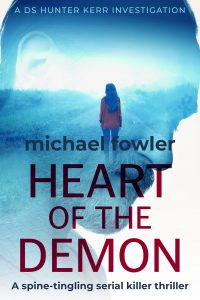
I started at about the age of twelve, and it was a science fiction apocalyptic story, written in two exercise books from Woolworths. I had an uncle, who was not only an avid reader but had a wonderful imagination, and as a teenager, I would spend many autumn and winter nights with him developing characters and drafting first chapters in front of a glowing coal fire with just a single table lamp burning. It made for a wonderful atmosphere and it was my uncle who introduced me to crime fiction.
Where and how do you like to write?
I have a study set out with everything I need. I start my day walking my dog on fields at the back of my home, and as I’m walking, I am working through what I will be writing when I return. I then hammer away at my keyboard for about five hours, doing some refining along the way, and then take my dog out for his second walk, reflect on the piece I have just written and do a mental edit. I’ll then return and make a few adjustments.
What part of the writing process do you find most difficult?
I am a constructive plotter, and so work out a beginning and end, and build in significant events in the middle, to drive the story. In my study I have a huge whiteboard, and I ‘run’ my stories as if they were a major incident (from my detective days), with photographs, timelines, and spider lines connecting characters to story, so I can keep track.
How much research do you normally do before you start writing?
Not a great deal. Because my crime novels are based very much on my previous career as a detective, I am drawing on those experiences.
How real do your characters become?
Many of my characters are based on people I know or have met, so it’s quite easy for them to own their story.
Do you ever feel guilty about killing off your characters?
Not the villains. As I have said above, they are generally based on the villains I have come across during my career and so I find bumping them off quite cathartic. However, I have just killed off one of my leading detectives in my Hunter Kerr series and I had a great deal of angst about doing so.
What are you working on at the moment? 
I am working on a new character who is a forensic psychologist in a psychological thriller, which is a huge shift for me as my previous novels are police procedurals.
What is your favourite book?
I am such an avid reader I don’t have a favourite book or character. However, there are a few recent reads that stand out among others, and they are: Into the Darkest Corner by Elizabeth Haynes; The Dry by Jane Harper; Her Every Fear by Peter Swanson; Fall from Grace by Tim Weaver, plus The Bone Field by Simon Kernick.
Which book do you wish you had written?
The Bone Collector by Jeffery Deaver – I love the unique element of a paraplegic crime scene examiner detecting a crime from his bed.
Tell us something surprising about you!
I am also an established artist. I have exhibited in London’s Mall Gallery with The Society of Marine Artists, The Society of Oil Painters and the British Federation of Artists. In 2009 I was awarded the SAA Professional Artist of the Year.
Michael Fowler is the author of the DS HUNTER KERR INVESTIGATIONS series.
Click here to order HEART OF THE DEMON – the first book in the series – now!
COLD DEATH – the second book in the series – is available to pre-order.
Hi Keith. Welcome to the Sapere Books blog!
Can you tell us a little bit about what first inspired you to write the Torquil McKinnon Investigations?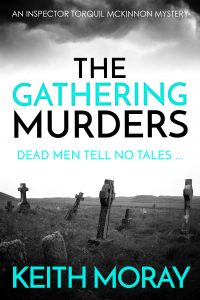
Well, I have been a crime fiction reader most of my life and always wanted to be a crime writer. I began writing children’s stories for The People’s Friend when I was a medical student at the University of Dundee. Then when I qualified, I wrote for the Kingston-upon-Hull’s dial-a-bedtime story service, until I had to give it up and focus on my medical practice. One of my forebears was a piper, and I thought that if I ever did write a crime novel it would have a piper in it. The germ of an idea was there.
A few years later I started having bagpipe lessons from a good friend and golf partner, who happened to be a retired pipe major. So, actually playing the pipes seemed to germinate the idea. Then we went on a family holiday to Tobermory in Mull and the whole thing seemed to unfold before me. A remote Outer Hebridean island with a primitive golf course and the smallest police force in the country, the Hebridean Constabulary. The ingredients were there, it just took a visit to a Highland Gathering on the mainland and I started to plot The Gathering Murders. The characters grew on me and the series just developed.
What was your reason for creating the fictional island of West Uist instead of choosing a real Scottish location?
I suppose I just fell into it. I had written several westerns long before I ever went to the USA, so I just started writing, amalgamating my own memories into my own wee island in much the same way that I had created towns and counties in the Southwest of America. I wanted West Uist to be Scotland in miniature. This is why the terrain varies, there is a great variety of surnames (far greater than in the Outer Hebrides) and I have introduced a different theme with each novel.
What are your typical writing habits? Do you work on a set schedule each day? Do you plan thoroughly before you begin writing?
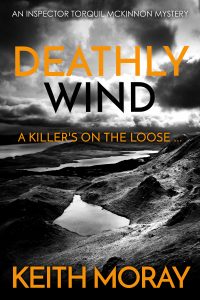 I am an opportunistic writer, so I write when I have done all of my essential chores for the day, such as looking after my small practice. I am also a medical journalist and have a written a weekly column in the local newspaper for 38 years, so I can identify with Calum Steele, the editor of the West Uist Chronicle. Because I used to write short children’s stories and now write a newspaper column, I tend to write in short segments. It has become part of my writing psyche. This suits my opportunistic method of working.
I am an opportunistic writer, so I write when I have done all of my essential chores for the day, such as looking after my small practice. I am also a medical journalist and have a written a weekly column in the local newspaper for 38 years, so I can identify with Calum Steele, the editor of the West Uist Chronicle. Because I used to write short children’s stories and now write a newspaper column, I tend to write in short segments. It has become part of my writing psyche. This suits my opportunistic method of working.
I carry a notebook everywhere and am forever jotting snippets down, to be incorporated later. I plot late at night in longhand. When I am actually writing then it will be on the computer, and that can be literally any part of the day.
I do plan it out and have never felt brave enough to just type and see where the story goes. I have a method of writing a novel that seems to work for me. A crime novel has so many elements to it: main plot, subplots, clues and red herrings. I work out each chapter and have a fair idea of what has to happen in each one.
What part of the writing process do you find most difficult?
Plotting is never easy. I go around asking myself ‘what if?’ That’s why I need my notebook handy. I would say it is 80 per cent of the work in writing the novel.
When I am working on the plot, I often play the pipes like Torquil (except he is a virtuoso and I am so abysmal that I am forbidden from playing if there is anyone else in the house). And I also putt golf balls across the landing into my study or chip balls onto the settee. Strangely enough, it facilitates ideas.
In terms of the visceral structure of the novel when I actually write, the middle part is the hardest for me. The first part is scene setting, putting people in the right places and ensuring that the crime happens early on. The middle part is about planting the clues, the red herrings and keeping the subplots going without letting them take over. The end part I already know what should happen, so the middle is about ensuring that you have put everything in place so that you can build it up for the final denouement.
Do you always know ‘who done it’ before you start drafting each novel?
Yes, in virtually all of my books I know who, where, when and how. But, I have to admit that I have on one occasion changed my mind while well into the story. It seemed to work, but I’m saying no more!
The sixth book in the series is due out soon – will that be the end for Torquil, or do you have ideas for more mysteries?
Gosh, I am honestly not sure. I would like to think there will be more, but I am working on other projects at the moment, which I am excited about. Torquil may not have finished with me yet.
And finally – tell us something surprising about yourself!
One of my hobbies is conjuring and I am a paid up member of the International Brotherhood of Magicians.
Click here for more information on Keith Moray’s Torquil McKinnon Investigations series.
THE DEADLY STILL, book five in the series, is available to preorder now.
Simon Michael is the author of the Charles Holborne Legal Thrillers, set in the 1960s. The Waxwork Corpse is Book Five in the series.
Like all the books in the series, The Waxwork Corpse is based on real events and real cases but this one you may remember, because it made the headlines.
In 1984 a man was arrested in connection with the death of his wife, a body having been found in Wastwater, the deepest lake in England, almost a decade after she went missing, supposedly with her lover.
I learned of the case while waiting in a barristers’ robing room for a jury to return with a verdict. How the killer had dropped the body tied to a kerbstone, in the middle of the night, from an inflatable dinghy into the dark waters of Wastwater. How it had, in a one in a million mischance, landed on the ledge of an underwater pinnacle named Tiffin’s Rock. How, in another extraordinary twist of fate, the ledge was at the perfect depth for the water temperature to preserve the body (the tissues had become “adipose”, wax-like, and so remained recognisable so many years later). And how, extraordinarily, the police happened to be looking for a missing young woman in the same area shortly after an amateur diver first saw the body underwater.
It would, I knew, make a wonderful story, and some years later, following the killer’s conviction for manslaughter and his discharge from prison, I got in touch with his solicitors. Did they think the man would allow me to interview him with a view to writing the story, I asked? They replied in the affirmative and, to my complete astonishment, sent me the case papers, witness statements, photographs, pathology and scientific reports — the complete file.
By then the man was out of prison, running a small B&B in a remote part of England. I got in touch and asked if I could come to interview him, and he agreed. Perhaps rather thoughtlessly in retrospect, I decided that the trip offered the perfect opportunity to take my wife and new-born daughter for a short break away from London.
The plan was to drive from London on Friday afternoon and spend the weekend at the B&B. My wife could walk on the beach while I conducted the interview. However, what nobody predicted, including The Met Office, was that one of the worst storms of the century was due to strike Britain that day.
By dusk, tall vehicles on the motorway in front of us were blowing over. Power lines were brought down by uprooted trees, huge swathes of the countryside were plunged into complete darkness as the electricity supply failed and torrential rain was hurled from the skies. Traffic was guided off the motorway and down narrow country lanes, at one point even being directed over waterlogged fields.
We finally arrived at our destination, a small seaside town, several hours late and in pitch darkness. It was still pouring, the fierce winds howling through the deserted streets and whipping the rain almost horizontal. There was no electricity; even the traffic lights were out.
Eventually, we found the address. We climbed out of the car and, immediately drenched, stepped over dislodged branches and other detritus and ran up the path to the front door. We were exhausted and irritable, with a baby who’d been inconsolable for hours.
I knocked on what we hoped was our host’s front door. At first there was no answer, but then a flickering light swayed down the hallway towards the door. A huge shadow darkened the glass, and the door was opened by an extremely tall man holding a storm lantern.
It was a scene straight out of a horror movie. He offered us hot drinks but my wife, completely spooked by then, insisted we went straight to bed. We climbed the narrow stairs, tired and famished, and entered our dark bedroom. My wife barred the door with a chair.
The next day, the weather was improved and the power restored. I asked my questions about the case and the evidence and the killer’s motivation, while my wife took the baby for a walk on the beach. The interview went well, and it was agreed that I could use the story as long as the man’s identity was obscured to protect his children.
Halfway through I realised that the man sitting opposite me was admitting, completely calmly, that he killed his wife in a fit of uncontrolled anger.
That afternoon I reported some of what I was told to my wife. As I repeated the story and saw the growing horror on her face, it dawned on me that staying for the weekend in an isolated B&B with a man possessing such an uncontrolled temper that he could kill his wife with his bare hands, no longer seemed like such a good idea.
We left that afternoon.
If you want to find out what the killer’s real motivation was, and whether or not he was actually guilty of murder, you’ll have to read The Waxwork Corpse!
Order THE WAXWORK CORPSE here.
Or find out more about the Charles Holborne series here.
Chapter 1
‘This —’ The owner of the house cleared his throat and tried again. ‘This is highly irregular.’ He tapped the letter from Whitmore Photographic. ‘The proprietor assures me that he will personally be taking Flora’s portrait.’
Julia McAllister glanced at the four-year-old, sitting bolt upright in her best pink taffeta dress. A froth of ringlets cascaded over her shoulders, and the silver locket round her neck twinkled in the meagre light. With her favourite dolls cradled in her arms, three of them in each, you could be forgiven for thinking the little mite was still alive.
‘My employer, poor man, his health took a turn for the worse.’ Julia flashed a tortured smile. ‘His heart, I’m afraid. Notoriously unreliable.’
‘Yes, but even so.’ Her client’s eyebrows met when he frowned. ‘A woman?’
Julia slotted the plate holder into her camera. She bit her lip, and reminded herself that this was just a job, another routine portrait — that she should knuckle down, take the picture, forget the subject was a baby.
‘Mr. Whitmore would not have entrusted me with such a sensitive task,’ she assured the grieving father, ‘unless he had every confidence in my ability.’
‘For my part —’ his wife’s voice was little more than a croak — ‘I’m comforted that a member of my own sex is looking after Flora. Women,’ she added shakily, ‘are infinitely more sympathetic, so come, dear.’ She pulled her husband’s sleeve. ‘Let us leave Miss McAllister in peace.’
Mrs., Julia wanted to correct. It’s Mrs. McAllister. But the death of their only child was testing the couple’s strength, their marriage and, judging from the cross on the mantelpiece that had been laid flat, their faith in Jesus Christ. Like families everywhere, too much in life had been taken for granted. It was only when the flame was snuffed, in this case without warning, that it was driven home how little they had to remind them of their loved ones. They wanted this picture to cling to and cherish.
‘Rest assured,’ she said, ‘I will do your daughter proud.’
Alone in the parlour, Julia took a series of deep breaths and forced herself to block out the red flock walls that threatened to close in, the gagging scent of lilies, the silence of the grandfather clock, whose pendulum had been removed and wouldn’t be replaced until Flora lay in her grave. How sad. How desperately tragic. When your husband dies, you become a widow. When your parents die, you become an orphan. Yet there’s no word to describe someone who loses a child.
To calm her nerves, Julia followed her familiar ritual of running her hand over the Spanish mahogany case of her camera, inhaling the leathery tang of the bellows and fingering the handmade dovetail joints. (None of those factory-made monstrosities, thank you very much.) By the time she’d given the brass fittings one last unnecessary polish, she felt in control, and disappearing under the heavy dark cover, she examined the image. After all this time, she hadn’t grown used to seeing the world upside down, but there, now — a quick tweak to the focus, a slight tilt to the left, a touch of back swing and —
Mother of God!
The girl’s hand moved.
Nonsense. It must have been a trick of the candles, and that was the problem with having the curtains drawn and the mirrors draped in black. The shadows played havoc.
There! It moved again!
Julia sloughed the sheet from her shoulders and squinted. Impossible. Flora fell downstairs and snapped her neck. In fact, the only thing holding her upright was a metal clamp under her pretty lace collar, and a rope, artfully hidden by dolls, tying the girl to the chair. Julia should know. She’d put them there.
No, no, no. The dead don’t —
‘Ow!’ a voice squealed.
‘Were you trying to steal that locket?’ Julia grabbed the young boy hiding behind the body.
‘Lemme go, you’re pinching!’
‘Did you think I wouldn’t spot a third hand? A third hand, I might add, caked with a six-inch layer of grime.’
‘I said lemme go!’
‘This will be a double exposure in every sense, if you don’t quit squawking.’ Julia examined the urchin in front of her. Eight, was he? Nine? ‘How did you get in?’
‘Door’s open, innit.’
Of course. The front door had been left partly open for mourners to enter without jarring the nerves already stretched past breaking point.
‘So you thought you’d sneak in and steal the locket that probably contains a clipping of her hair, which is all her mother has to remember her only daughter by?’
The defiance crept out of the boy’s face. ‘You gonna report me to the rozzers?’
‘No.’
‘Why not?’
‘Because these are good people, who don’t need to know that some stray urchin crept in their house, defiled their daughter’s body and was caught stealing her precious locket. They’ve suffered tragedy enough, and I won’t have you adding to their misery.’
‘Wotcha gonna do, then?’
‘I am going to take this girl’s portrait, that’s what I’m going to do, and you, sir, are going to help me.’
‘Me? I don’t know nuffin’ about photographs.’
Julia fluffed the girl’s lace collar to hide the mucky handprint on the taffeta. ‘You don’t need to. Just hold the curtain open — the left one if you please — to throw some decent light in the room.’
‘Like that?’
‘Exactly like that.’ She pressed the shutter release, changed the plate, took another, then another, then another.
‘Why d’you take so many?’ He sniffed, and wiped his nose on his sleeve. ‘It’s not like she’s gonna move and throw the focus out.’
‘For someone who professes to know nothing about photography, you seem remarkably well informed. However, your expertise is no longer required, young man. Time for you to leave, preferably in the same covert manner in which you arrived.’
‘Can’t I —?’
‘Shoo.’
Julia packed up her camera, collapsed her tripod and dismantled the contraption that was holding Flora upright, before packing her accessories back in the case and promising the grieving couple that Whitmore Photographic would be giving Flora’s portrait the utmost priority.
Outside, Julia felt the weight lift from her. After a month of non-stop drizzle that had combined with the smoke from the factories to form a choking, brown, sulphurous stew, the sun was a welcome sight, and Julia wasn’t alone in her joy. Half the population of Oakbourne, it seemed, had turned out to celebrate. The street shimmered with jewel-coloured silks, wide hats festooned with feathers, wasp waists, and shoes with toes so pointed they could put an eye out. Impressive moustaches paraded beneath dark derby hats. Parasols twirled, hansom cabs rattled, and (shock, horror!) could that really be ladies riding bicycles in bloomer suits? Flower girls proffered violets, carnations and stocks a penny a bunch, puppies chased their own tails and a boy played a harp taller than himself to an enraptured audience on the corner.
Stopping at the strawberry barrow, Julia smelled her scrawny assistant before she saw him. ‘You again.’
‘Seeing as how I helped out back there, I thought you might wanna give me sixpence for me troubles.’
‘How about I give you a clip round the ear?’
‘Cow,’ he muttered. Julia checked her black beaded purse. Strangely, it was still there. ‘Threepence, then.’
Dear Lord, give me strength. ‘Suppose we say no pence, and I don’t call the police?’
‘Suppose I went up your chimney and cleaned it?’
‘You’re too old, you’d get stuck, and by the time you’d starved to death and your skeleton dropped out, I’d have died from frostbite, waiting. Go away.’
‘I’ll settle for a ha’penny.’
Julia pulled the boy out of the path of a hackney cab and pointed with her strawberry in the opposite direction to which she was headed. ‘Go. Now.’
‘S’pose I said I wasn’t stealing nuffin’. S’pose I told you, I just wanted to see what a pretty girl looks like dead, coz the only corpses I seen are under the bridges by the canal, and them’s anything but pretty.’
Against her better judgment, Julia gave him her last strawberry. It disappeared whole, green bits, stalk, and all. ‘What’s your name?’
‘Bug.’
‘Bug?’
A grubby shoulder shrugged. ‘Short for Bugger Off, which is what most people —’
‘No explanation required. In fact, I can well see the attraction in offering that particular piece of advice, but tell me — Bug — when was the last time you took a bath?’
‘What’s it to you?’
‘Personally, very little.’ Julia set down her clutter of camera, tripod, cases and clamps. ‘In terms of community service, however, I feel it only fair to remedy the situation.’
Grabbing him by the collar with one hand and the seat of his moth-eaten pants with the other, Julia dropped Bug in the horse trough.
The resulting yells were more than satisfactory. Even if the language wasn’t.
But it was little Flora’s face that stayed with Julia as she pushed through the crush of Cadogan Street and into Westgate Road. Requests for post-mortem photographs — memento mori, as they were popularly called — were becoming more and more common, and this was by no means the first that Julia had taken. Some of her subjects were old, well into their eighties, some were children, a few already laid out in their coffin. Rather memorably, one old chap had begun to decay.
For the sake of authenticity, some of her clients she propped standing up, some with their heads in their hands, some leaning back with a newspaper as though they’d nodded off in mid-read. One lady the family had wanted sitting at a table laid with glassware, cutlery and plates, as though waiting for her dinner guests. Many, like little Flora, had their eyes open. With others, she painted their eyelids to make it look like they were posing for the camera. She perched dogs on their laps. (Stuffed, of course — live animals don’t sit still long enough for the exposure). Several were arranged with their entire families around them and on one notable occasion, it had been impossible to tell which of the eight was the corpse.
None — not one — of those subjects had affected her like this.
Perhaps it was because Flora was an only child, and the mother was of an age when she was unlikely to conceive again. Perhaps it was the dignity with which the couple bore their grief. Perhaps it was the little girl herself, taken in the blink of an eye. Either way, this morning left a nasty taste in Julia’s mouth. One that even the reddest, ripest strawberries couldn’t take away.
‘Ah. The lady photographer, I presume?’
Julia eyed up the man waiting outside her shop, set down her equipment and proceeded to unlock the door. He didn’t look bereaved, was too old to be getting married, and too young to have a daughter needing a wedding recorded for posterity. In fact, in his smart grey lounge suit, derby hat and cocky air, she wouldn’t mind betting he wanted to commission a portrait of himself. Recorded for posterity.
‘What exactly are you wanting, Mr —?’
‘Collingwood.’ For all the width of his smile, it didn’t reach his eyes. Eyes, the artist in her noted, the same hue as his suit. ‘Inspector. Detective Inspector Collingwood, of the Boot Street Police Station. You’d be Miss —?’
‘Mrs.’ Julia hoped that stacking her equipment would excuse not shaking hands. Shaking being the operative word. ‘It’s Mrs. McAllister,’ she said. ‘Now what can I help you with, Inspector? An official police photograph, taken in the station?’
‘Not exactly.’ He walked slowly round the shop, examining the frames on display, the portraits hanging in the window, the showcase of photos, the little china dogs on sale as a side-line. ‘Does the name Eleanor Stern mean anything to you?’
Relief washed over Julia, leeching the strength from her knees — its place instantly taken by a new surge of anxiety. Nellie, Nellie, what have you done now?
‘Can’t say it does.’
‘Lily Atkins?’
An image flashed through Julia’s head. Black stockings drawn over chubby knees. Enormous breasts. The coquettish twist to Lily’s lips as she tweaked her own nipple.
‘Again, no, doesn’t ring a bell.’
‘Hm.’ Collingwood paced a bit more. He stared out of the window at the Common, where lovers strolled arm in arm beneath the oaks, ladies of a certain age walked their Pomeranians, and nannies in uniform pushed perambulators as they eyed the soldiers from the corner of their eye. ‘Bridget O’Leary, though. Surely you know her?’
‘Sorry…’ No smile was ever more apologetic. ‘Then again, a lot of ladies have their portraits taken, Inspector. I could check the ledger, if you like?’
‘That won’t be necessary.’ The pacing changed from clockwise to anti-clockwise. ‘Mr. Whitmore.’ He ran his hand across a silver frame with embossed cherubs on the corners. ‘He left you this business when he died, is that correct?’
‘He did.’
‘Yet four years later, you haven’t changed the name above the shop, and still pretend to clients that Samuel Whitmore’s alive?’
If it had been anyone else, she would have passed that off as respect to her benefactor’s generosity. Unfortunately, there are only so many lies you can tell the police.
‘Pretend is a strong word, Inspector. As a woman fighting to survive, not only in commerce but in what is very much a man’s world, I find it simpler not to disabuse them.’
‘Of course.’ Collingwood switched his derby from his left hand to his right, then back again. ‘And you’re not familiar with the names Lily Atkins, Bridget O’Leary and Eleanor, more commonly known as Nellie, Stern?’
‘I thought we’d already agreed I am not.’
‘Had we? Because these photographs were found in their rooms.’
One by one, he laid them on the walnut counter like a deck of cards. All three were along the lines of the image that had flashed through Julia’s mind a moment before. Although in Nellie’s case, perhaps a little more so.
‘Inspector!’ Julia swept them off the counter. ‘How dare you bring such filth into my premises!’
Something twitched at the side of his mouth as he bent to retrieve them. With luck, it was indigestion. ‘My apologies if the content offends you, Mrs. McAllister, but you notice that, on the reverse of these prints, is your stamp.’
Damn. She never put her address on the back of any incriminating — Wait. Whitmore Photographic? In her distinctive purple ink…?
‘I have no idea how that got there.’ And that was the truth. ‘But as far as I’m aware, no law has been broken in either posing for pornographic photographs, or taking them.’
‘Quite so. The crime lies in the possession and distribution of lewd material, although it piques my interest that you’re aware of this fact.’
A trickle of sweat snaked down Julia’s backbone. ‘You wouldn’t believe the requests I receive from certain members of the public.’
‘Hm.’ Collingwood’s grey eyes — wolf’s eyes — held hers for what seemed like two days, but was probably only a couple of seconds. She swore she heard the dust motes hitting the ground. ‘Your husband.’
‘James.’
‘Where might I find him?’
‘The Sudan.’
One eyebrow rose. ‘Fighting in the campaign?’
‘Buried there.’ Julia smoothed her skirts. ‘Now then, Inspector, if you don’t mind, a grieving family needs a portrait of their daughter — the only image they will have to remember her by.’
‘I understand. You need to get to work.’
‘The matter is pressing, and despite my trade plate on the back of these vile photographs, I assure you, I know nothing of their provenance, and to be honest, I’m offended that you think me acquainted with strumpets such as these.’ She forced a smile. ‘On the other hand, I can see how you made the connection, and — well, far be it for me to tell you your job, but wouldn’t it be simpler to ask the girls about the pictures?’
‘Strange as it might seem, that thought occurred to me, as well.’ Collingwood picked up a china dog, a King Charles Spaniel as it happened, examined the pottery mark, then replaced it in the exact position in which he had found it. ‘The problem with that line of enquiry is that all three are dead.’
‘I am sorry to hear that.’ Nellie? Lily? Little Birdie…?
‘Murdered,’ Collingwood said quietly. ‘And from what I can gather, Mrs. McAllister, you work alone on these premises, without an assistant.’
Breathe … breathe…
‘I’m sure there’s a point to that observation, Inspector.’
‘My point, Mrs. McAllister, is that all roads lead to Rome.’ He picked up another china dog, a Skye Terrier, and proceeded to examine it. ‘And you, it would seem, are standing in the middle of the Forum.’
Need to keep reading and find out what happens to Julia? Buy Snap Shot here now!
On Thursday evening, we attended the Crime Writers’ Association Dagger Awards at the Leonardo Royal Hotel London City – a starry celebration of the best crime writing of the year in the UK.
We are the proud sponsors of the Sapere Books Historical Dagger Award, which recognises the best historical crime novel of the year. From a shortlist of six, the fabulous Destroying Angel by S. G. MacLean was chosen as the winner!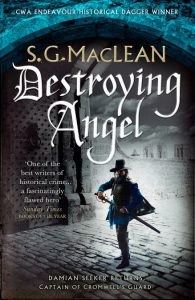
Set in 1655, Destroying Angel is the third novel in MacLean’s popular and critically acclaimed Seeker series. The first book in the series, Seeker, won the Historical Dagger in 2015, so this is a second win for MacLean’s excellent series.
This third book follows Captain Damian Seeker, a trusted member of Oliver Cromwell’s guard, as he travels to the Yorkshire village of Faithly to enforce the government’s anti-Royalist laws. Upon arrival, Damian is invited to dinner at the home of Faithly’s Puritan commissioner, Matthew Pullan – a tension-filled gathering that ends with Pullan’s young ward, Gwendolen, being fatally poisoned.
With suspicion and bitterness rife in the village, Damian must discover whether Gwendolen’s death was an accident or something more sinister. Atmospheric and full of compellingly unsavoury characters, Destroying Angel’s meticulous historical details and intricate narrative keep the reader absorbed throughout.
We would like to congratulate S. G. MacLean on her well-deserved win and applaud all of the shortlistees for their wonderful work!
You can order all the books in S G MacLean’s Seeker series here.
We would also like to say a massive thank you to CWA Chair Linda Stratmann, Vice Chair Jean Briggs and everyone else on the CWA committee who put in some much hard work organising the event! We are very happy to be building an ongoing relationship with the Association and we can’t wait for next year.
We are the proud publishers of both CWA Chair Linda Stratmann and Vice Chair Jean Briggs’ novels.
Click here to find out more about Linda Stratmann’s Mina Scarletti series.
Click here to find out more about Jean Briggs Charles Dickens Investigations series.
Chapter One – 1891
When pathologist Jacob Bryce got to the third stab wound, he knew that it was not one of the ordinary back-alley robberies which constituted most of the murders in New York City’s notorious 4th Ward.
Most of the blood, concentrated around the woman’s chest and stomach, had coagulated into a thick skin, indicating that death had taken place several hours beforehand. Bryce had to use alcohol to clean and loosen the blood in order to view those first puncture wounds.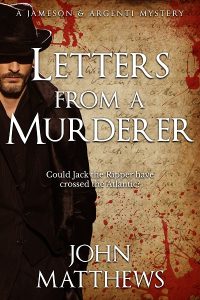
It was the practice at Bellevue hospital that whenever a body was brought in for autopsy one of the crime-scene detectives should also be present to pass on key information when queried. Bryce looked towards the attending detective, whose name he couldn’t recall and who still looked somewhat in shock.
‘What time did you first discover the body?’
‘Uh, we got there, myself and a colleague from Mulberry Street, at just before midnight.’
‘And the first people to discover the body — when might that have been?’
The detective briefly consulted his notes. ‘Another girl from the Riverway Hotel first noticed her in a side-alley forty minutes before we arrived.’
‘Much activity in the area that time of night?’
‘Yes. Quite busy still.’
Bryce nodded thoughtfully. Add on at most half an hour for her body to first be discovered then the two hours since midnight taken up with initial forensics at the crime-scene and transporting the body in an ambulance-wagon to Bellevue.
The deep gash to the side of the woman’s neck, severing the carotid artery, wouldn’t on its own have been unusual for a street robbery; it was the fact that it was combined with so many stab wounds — Bryce had counted eight so far. Blood flow from the neck-wound was less, indicating that the stomach wounds had come first.
By the time Bryce had located the fourteenth stab wound, he realized he was in unchartered waters; it was like nothing he’d seen before. The smell of body waste mixed with carbolic and alcohol was heavy in the air. The young detective was now even more wide-eyed and looked slightly nauseous, one hand going to his mouth.
Bryce noticed a small X marked on the woman’s left shoulder. He’d get a photo taken of it later. A keen follower of Virchow’s principal, Bryce had a neat line of glass jars prepared and labelled, ready — once they’d been initially examined and weighed — to take each of the body’s internal organs. But he soon discovered that two of those jars would go unfilled. He looked towards the detective.
‘Were any body parts removed from the scene? Perhaps bagged and taken elsewhere for examination … or inadvertently left at the crime scene?’
The detective looked flustered. ‘No. None that I know of.’
‘The scene was searched thoroughly — nothing left there?’
‘Yes. I’m sure it was.’
Bryce wondered whether the scavenging rats and dogs of the area might have run off with the woman’s liver and kidney. Half an hour? Unlikely in such a short period, but regardless the killer had first removed those organs. Yes, like nothing he’d seen before — although he had heard of something similar.
Bryce looked at the clock on the wall. Five hours before Inspector McCluskey was in his office for him to pass on the information.
‘Come now. This Darwin fellow was clearly deranged.’ Viscount Linhurst swirled his brandy balloon at London’s St James Club. ‘Evolved from monkeys? We’re clearly the far higher species.’ With a captive audience of two of London’s leading surgeons — Sir Thomas Colby and Andrew Maitland — he thought it an apt time to air such views.
‘You’d never guess it from any of my household staff,’ Maitland commented.
There was a light guffaw from Linhurst, but Colby remained serious. ‘I don’t know. I see the similarities daily in autopsies. Every single organ in the same place — liver, stomach, spleen — and every bone and joint the same, too, right down to the little finger.’ Colby held up a pinkie. ‘I wouldn’t discount it so hastily if I were you.’
‘I’m not convinced.’ Linhurst tapped his forehead. ‘It’s all here, you see. And Darwin hasn’t adequately explained how a monkey could possibly —’ Linhurst broke off as a club usher approached.
‘I apologize for the intrusion, gentleman, but there’s an urgent call for Sir Thomas.’
Colby unfolded the note held out on a silver tray. ‘Sorry. Excuse me a moment.’
He followed the usher towards the vestibule call booth and at the other end Police Commissioner Grayling wasted little time with preamble.
‘There’s been another one.’ Silence. Grayling wasn’t sure if it was purely shock or Colby hadn’t immediately made the link. He added: ‘Similar to the other eight.’
‘Where? Whitechapel again?’
‘No. You’d hardly credit it when I tell you. It’s across the sea: New York.’
But Colby wasn’t that surprised. With the last murder more than a year ago now the supposition was either that the Ripper was imprisoned, dead, or had moved on.
‘Who is handling the investigation there?’
‘McCluskey.’ Octave lower, derisory. ‘But, no matter — you’ll need to go over as soon as possible.’
‘I see. I hazard he didn’t request my involvement.’
‘No. I did. Your contribution is invaluable to match the crimes. There’s also the possibility that it’s a copycat murder: as you’re well aware there has been far more in the press about this than we’d have liked. But if a link is proven we still have by far the heavier case burden: eight murders that remain unsolved.’
Colby didn’t need reminding: three years that had consumed his life like never before. The number of murders attributed to the Ripper ranged from five to as many as eleven, but eight was the number Colby had personally cited as having links. No past investigation had attracted such strong public furore and a Fleet Street eager for fresh readers hadn’t helped.
‘There was also a mark left on this one,’ Grayling said. ‘A small X on her left shoulder.’
‘Oh?’
‘It might be significant, it might not. Or indeed, it might mean that this is a different man entirely: not the Ripper at all. We won’t know until we get the full details.’
‘Yes, I see.’ Colby sighed. ‘One problem, though. I have an important speech at the Royal College of Surgeons in two weeks time that I must be here for. I won’t be able to go until after that.’
‘I’m not sure matters will hold that long — aside from the politics. McCluskey would no doubt start bleating about our incompetence again. Can’t you delay it — speak there later?’
‘No, it’s an annual event. But that’s not the only problem.’ The rest of Colby’s hectic social calendar flooded in: his son’s upcoming investiture at Sandhurst, a dinner-dance invitation from Lord and Lady Northbrook that he’d face untold woe from his wife for missing. ‘I fear I’m not going to be able to go over.’
‘I’m sorry to hear that. I suppose I’ll just have to tell McCluskey the bad news — or probably good from his point of view. He’ll be relieved no doubt that we aren’t interfering, as well as now have first-hand proof of that incomp—’
‘I have a suggestion,’ Colby cut in. The thought had struck as Grayling started riding him. ‘One of my best students went over to New York four months ago. An aunt who he was close to — she raised him after his mother died — was very ill. He could stand in for me.’
‘But would he be competent enough?’
‘Very much so. My main protégée, you could say. Of all my students, he was the only one to identify crucial links in the Ripper case without my constant prompting. Uncanny — almost as if he knew the man personally.’
‘I see.’
‘And, of course, I could give him added consultation by telegram and letter from London.’
‘Yes, I suppose it could work,’ Grayling said at length. ‘But if he’s picked up on any of the scuttlebutt in London, tell him not to use our pet-term, Inspector McClumsy — get us off on the wrong foot. And what’s his name, by the way?’
Colby swallowed back a chuckle. ‘Jameson. Finley Jameson.’
‘Mr Jameson… Mr Jameson!’
The voice had a slight echo, as if it was at the end of a tunnel, and it took Finley Jameson a moment to focus on the wizened Chinaman hovering over him and realize where he was. The smell of opium smoke and incense was heavy and Jameson wasn’t sure if the mist was just in the air or behind his eyes.
‘Mr Jameson… Lawrence is here. Says he has an urgent message for you. Shall I show him in?’
That snapped Jameson to. He sat up, rubbing his head. Years back in his university days, he’d had a shock of wavy, wild blond hair, but now, cropped short, it looked much darker.
‘No … tell him to wait. I’ll be out in a few minutes.’ He didn’t want his assistant, Lawrence, to see him like this. He wouldn’t understand.
‘Do you want me to get Sulee to bring you some tea? Help you waken?’
‘Yes … thank you. An excellent suggestion.’
Sulee, more distant through the mist, gave a small bow as she went to make him tea. Her lithe beauty was apparent despite the plain high-collar shirt and loose trousers of any laundry worker.
He recalled Ling offering for a dollar that Sulee give him a scented oil massage while he smoked; for another dollar she’d apply the oil with her naked body and then lick it off inch by inch ‘like a cat’.
Jameson thought he’d politely declined, but when later he seemed to remember Sulee’s oiled body writhing against him, he wasn’t so sure. Then halfway through her eyes became vertical ovals and her skin transformed to that of a tiger’s, complete with stripes — unless it was the candlelight throwing shadows through a nearby palm — so perhaps it had been a dream after all.
The main thing to attract Jameson to these dens was that wonderful merging between dreams and reality. But was death always what triggered his visits? Certainly, the first time he’d visited one had been not long after his mother’s death and it couldn’t be sheer coincidence that his visits since had often been following his and Colby’s most traumatic autopsies. Now, too, this visit to Ling’s had come straight after his aunt’s death and often his past visits to dens had taken place when other problems had arisen in his life. Was he escaping personal demons or merely enjoying a harmless ethereal distraction? After a moment, he shrugged the thought away. As often, he found himself more at ease studying the intricacies of the lives of others than his own.
Compelled to keep reading? Buy Letters from a Murderer now!
Sapere Books are proud to be sponsoring the Crime Writers’ Association’s Historical Dagger Award, which is for the best historical crime novel set in any period at least 50 years prior to the year in which the prize is presented. Read on to find out more about this year’s stunning shortlist!
Destroying Angel, S. G. MacLean, Quercus Fiction
Set in 1655, Destroying Angel follows Captain Damian Seeker, a trusted member of Oliver Cromwell’s guard who travels to the Yorkshire village of Faithly to enforce the government’s anti-Royalist laws. Upon arrival, Damian is invited to dinner at the home of Faithly’s Puritan commissioner, Matthew Pullan – a tension-filled gathering that ends with Pullan’s young ward, Gwendolen, being fatally poisoned. With suspicion and bitterness rife in the village, Damian must discover whether Gwendolen’s death was an accident or something more sinister. Atmospheric and full of compellingly unsavoury characters, Destroying Angel’s meticulous historical details and intricate narrative keep the reader absorbed throughout.
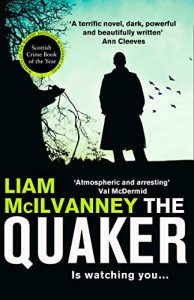 The Quaker, Liam McIlvanney, Harper Fiction
The Quaker, Liam McIlvanney, Harper Fiction
In the midst of a harsh Glasgow winter in 1969, DI Duncan McCormack is searching for a Bible-quoting murderer: the Quaker. The Quaker has already lured and killed three women after meeting them at a popular club – The Barrowland Ballroom – but so far attempts to capture him have been futile. When the body of a fourth woman is suddenly found, McCormack’s resolve stiffens as he plunges into a grim and intense pursuit of the truth. Based on the real-life story of serial killer ‘Bible John’, The Quaker is a darkly convincing portrayal of a city held captive by terror. The novel should also be commended for its effective use of multiple perspectives and skilful twists.
Smoke and Ashes, Abir Mukherjee, Harvill Secker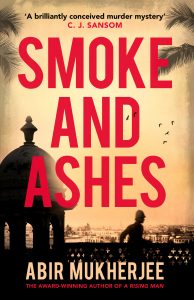
Smoke and Ashes follows Captain Sam Wyndham of the Calcutta police force – a secret opium addict who finds himself trapped in an illegal den during a police raid. As he makes his escape, he comes across a man who has been brutally murdered. And when he later finds a second corpse – apparently killed in the same ritualistic fashion – Sam begins to suspect that the two are linked. Fighting to keep his own vices in check, he teams up with Sergeant Banerjee to investigate the grisly deaths. Evocative and richly detailed, Smoke and Ashes should be praised for its powerful realisation of its setting – India in 1921 – and the strong narrative voice of the embittered, haunted protagonist.
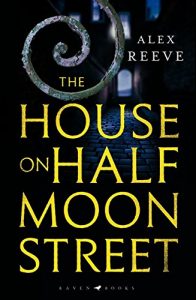 The House on Half Moon Street, Alex Reeve, Raven Books
The House on Half Moon Street, Alex Reeve, Raven Books
Leo Stanhope is a coroner’s assistant with a lifelong secret: he was born Charlotte – the daughter of a countryside reverend – but always knew that he was a man. Having run away to London at the age of fifteen, his dearest wish is to one day make a home with the woman he loves, Maria, and be free to live his truth without fear. But when Maria is murdered, Leo’s hopes are crushed and his freedom threatened. Heartbroken but determined, he vows to find her killer and becomes embroiled in the dark underbelly of the city. With its realistically gloomy Victorian ambience, well-paced plot and thoughtful characterisation, House on Half Moon Street is both gripping and tender.
Tombland, C. J. Sansom, Mantle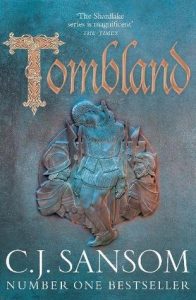
Two years after the death of Henry VIII, lawyer Matthew Shardlake is working for the old king’s daughter, Lady Elizabeth. When Edith Boleyn – the estranged wife of Elizabeth’s distant relation John Boleyn – is found murdered, Shardlake travels to Norwich to investigate. There, against the simmering backdrop of the peasants’ rebellion, Shardlake finds a dangerous, multi-layered plot waiting to be untangled. A sweeping, epic read, Tombland is to be admired for its lively evocation of Tudor England and effortlessly interwoven sense of mystery and unease.
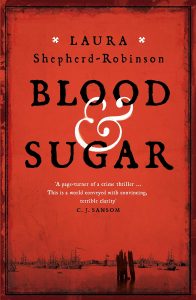 Blood & Sugar, Laura Shepherd-Robinson, Mantle
Blood & Sugar, Laura Shepherd-Robinson, Mantle
In 1781, prospective parliamentarian Captain Harry Corsham returns from the war in the US to find a chilling puzzle awaiting him. A body has been found in Deptford, horrifically murdered and bearing a slaver’s mark. At the same time, Harry’s friend, Tad Archer, has gone missing. An abolitionist, Tad had been gathering shocking information in the hope of bringing an end to the British slaving industry. Determined to find out what happened to Tad, Harry follows the trail of secrets into a web of danger and conspiracy. A thrilling and powerful debut, Blood & Sugar is both an immersive mystery and an unflinching portrayal of the atrocities of the slave trade.
The winner will be announced on the 24th October at the Leonardo Royal Hotel London City. Tickets to the award ceremony are available here.
Michael Fowler is the author of the DS HUNTER KERR INVESTIGATIONS series.
In 2010, after 32 years as a cop, and an even longer time as a passionate writer and lover of crime fiction, Heart of The Demon — the first in the DS Hunter Kerr series — materialised as the book I always told myself I could write.
It is inspired by a true crime event. As a Detective Sergeant, I was following up information in relation to a girl who had been missing for a number of years, and much of her previous history was recorded on her original missing report that had been filed away and stored in the basement at Barnsley Police station.
Whilst seeking it out, I came across a large cardboard box, which, upon rooting through, I found it contained the court file and crime scene photos for a man called Peter Pickering, who was dubbed ‘The Beast of Wombwell,’ and I couldn’t resist rummaging through the contents to get an insight into his crimes.
Peter Pickering was first convicted of attacking two schoolgirls in 1966 and was jailed for six years.
In 1972, five months after his release, he abducted 14-year-old schoolgirl Shirley Ann Brody in his home town of Wombwell, near Barnsley, drove her to secluded woodland, where he raped her and stabbed her while wearing yellow washing-up gloves — a detail that gave rise to his other tabloid nickname, the “maniac in the marigolds”.
Following that murder he was locked up in a psychiatric hospital, but it was always believed he had committed more attacks and murders, and he was interviewed by detectives on numerous occasions over several decades. The focus of those interviews were the murders of 14-year-old Anne Dunwell, from Rotherham, in 1964, and 14-year-old Elsie Frost, from Bradford, in 1965.
He refused to cooperate. However, following another investigation, detectives found evidence linking him to the rape of a Sheffield woman, committed just weeks before he abducted and murdered Shirley Ann Brody, and last year, at the age of 80, he was convicted of that rape.
Early this year Pickering died, taking his secrets to the grave. The finding of the Peter Pickering case file in Barnsley Police Station basement became a light-bulb moment for me as a writer, and has not only provided some of the background for Heart of the Demon, but has also inspired another of my Hunter Kerr novels, Shadow of The Beast.
Michael Fowler is the author of the DS HUNTER KERR INVESTIGATIONS series.
Click here to order HEART OF THE DEMON now!
When did you first start writing? Did a specific event encourage you to start?
I started writing when I was a teacher. I first wrote short plays for performance. When I gave up teaching in 2012, it was the bicentenary of the birth of Charles Dickens. When I read that he had a secret desire to be a detective, I wondered if I could write the crime novel that I had always wanted to write, so I gave it a try with Dickens as my detective.
How much research do you do?
Because my novels are historical crime novels, I need to do a lot of research into Dickens’s life and times, and into nineteenth century forensics. I need to know what the Victorians knew about poison, or stabbing, or shooting, or drowning and post mortems in the mid-nineteenth century.
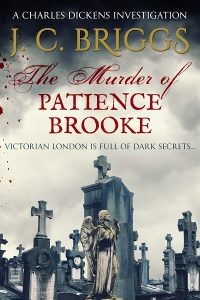
Tell us about where you write / your writing habits.
I write in a little room in my house. I often write sections of the novel long-hand and then type them up and make changes as I go. I always carry a notebook to jot down ideas when I’m on a train or waiting for someone – you never know what you might overhear!
What part of the writing process do you find most difficult? Starting, knowing when you’ve done enough research, the ending
I find it easy to start. Often the beginning of a novel comes from something I’ve read, especially something from Dickens’s letters. Then I get stuck in working out the plot, especially when I find that X couldn’t have done the murder at that point because she/he was somewhere else at the time!
How real do your characters become and do they ever seem to control their own storyline?
Very real – that’s why I enjoy writing a series. You can bring characters back. It’s very odd how characters you expected to play a minor part in the story start to develop in ways you had not planned and begin to play a major role. Then they seem to have a back story and you think: where did that come from?
Do you ever feel guilty about killing off characters or do you relish it?
It’s always satisfying to get rid of the murderer because that means the case is solved. And there have to be other victims – one murder doesn’t make a crime novel. You can’t help relishing the dramatic deaths, but sometimes you do feel sorry for the victim. Then you think: sorry, but you’ve had your lot, it’s time for another killing – keep up the suspense!
Do you find it hard to know when to end a story?
Not in the sense that you know it’s over when the case is solved, but you also have to think carefully about the very last paragraphs. You want to leave the reader thinking about the effects it has all had on the characters who are left and what their futures hold – if they have one.
What are you working on?
A novel which begins in Ferrara where Dickens went in 1844; I found a letter he wrote from there in which he describes some girls looking down into a stretch of water. It was twilight, the sun was setting and the walls of the castle were blood-red. Dickens writes that he knew the place although he had not been there before and that it chilled his blood. I wondered what those girls were looking at in the water and why Dickens was suddenly frightened. Murder?
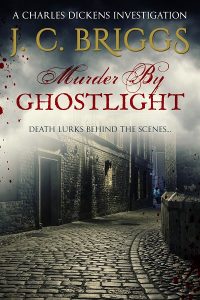
What are you reading right now?
Bleak House
What is your favourite book? Who is your favourite character?
Great Expectations. Miss Havisham.
What book do you wish you had written?
So many, it’s too hard to choose, but there’s a wonderful book: Pinkerton’s Sister by Peter Rushforth, which is so rich in character and incident and full of all kinds of literary allusions that I can’t help wishing …
Do you love any genres/books that are very different from what you write?
One of my favourite authors is William Trevor; I’ve just finished The Silence in the Garden which is about Ireland before the First World War. I love fiction about Ireland.
Tell us something surprising about you!
I was the voice over in a television show in Hong Kong. I was a puppet named Violet the Vulture – I played her as a kind of avian Lady Bracknell. My husband, who wrote the show, was Barney the Bear, and we had a kangaroo called Alice Springs.
Chapter One
Sunday, March 28th, 2010
Danny Sanchez arrived at 10:27.
It was already bedlam; hundreds of people covered the dusty patch of waste ground beyond the white walls of the property, shouting, pushing, arguing among the cacti and scruffy palms. The excavator’s arm loomed menacingly above the roof of the two-storey villa.
The demolition had been scheduled for nine a.m., but frantic negotiation had earned the elderly expat owners a three-hour stay of execution while the house was cleared. The whole neighbourhood turned out to help, Briton and Spaniard alike. A stream of people walked back and forth along the edge of the unpaved road, carrying everything and anything they could salvage – doors, windows, even the kitchen work surface. The problem now was where to put it all. An incongruous pile of household items was collecting around the trunk of a fan palm. Danny watched as a negligee blew free from a box and wrapped itself around a cactus.
Christ, what a mess.
In eighteen years of journalism, Danny had witnessed dozens of horrors – people cut from the wreckage of car accidents, a woman leap from a burning building, a suicide on a railway track – but this was something new. They were going to demolish Peggy and Arthur Cookes’ house and nothing could be done to avert it. He’d seen the paperwork. Nearly every penny the poor old duffers had was invested in the villa; a lifetime’s equity would be smashed to rubble. It was like waiting for an execution.
The Junta de Andalucía, southern Spain’s regional government, had sent a woman in her mid-thirties to oversee the demolition. Crafty, Danny thought; people found it harder to get angry with a woman, especially an attractive one. Her hard hat and fluorescent bib bobbed at the centre of a tightly-knit group of people. Guardia Civil officers in green boiler suits formed a protective ring around the Junta woman. Then came the leaders of the protestors, waving documents and trying to argue over the shoulders of the Guardia officers.
Behind them was the press pack, two dozen strong, cameras and microphones waving above the crowd as it surged and rocked. Gawkers and curious children milled at the edges, wondering what all the fuss was about.
For her part, the woman from the Junta looked genuinely distraught at what she had to do. Danny had no idea whether she could follow the English words being bellowed at her, but it was obvious she understood the gist. She kept pointing to the paperwork on her clipboard, raising hands and shoulders in shrugs of helplessness. Someone, somewhere had decreed the demolition must go ahead; it was her job to get it done.
The Cookes were inconsolable. Peggy sat on an armchair that had been dumped among spiky clumps of esparto grass. Tears carved streaks through the dust that had settled on her face. Danny recognized the armchair; he’d sat in it when he’d interviewed them a year before, when the demolition orders were first served. Arthur Cooke had looked dapper and defiant as he posed for the cameras back then; now, every one of his seventy-three years weighed upon him. He stood with his hand on his wife’s shoulder and turned moist eyes as Danny approached.
“Not now, mate,” he said, shaking his head. “The bastards are about to ruin us.”
Danny nodded, glad he’d been spared having to ask the obligatory “How do you feel?” It was amazing how dumb those four words could make you feel sometimes.
Peggy Cooke wanted to speak, though. “Why us?” she said, her voice shrill. “Out of all the hundreds of people, why does it have to be us? I want you to print that. It’s not fair.”
Why us? That had been everyone’s first reaction in March 2009 when the judicial demolition orders were delivered to eleven different families dotted around the municipality of Los Membrillos. It seemed so monstrously unfair, given the scale of the problem in Almeria, the province that occupies Spain’s south-eastern tip. A Junta survey had uncovered more than 12,500 irregular constructions in just ten of the worst affected municipalities. But the Spanish legal system was a Heath-Robinson contraption manned by characters from Kafka; immense and baffling in its complexity, arbitrary in the decisions it dispensed and spitefully prescriptive when it did so. It was one of the dangers of emigrating to Spain, the flipside to all the sunshine, fiestas and good living.
Not that it had worried the tens of thousands of Britons who had flooded the Almanzora Valley at the turn of the century, buying up villas and plots of land for self-builds, breathing life into the moribund rural communities that nestled below the Sierra de los Filabres mountain range. But the rush to expand had left thousands caught in the legal quicksand between the local and regional government of Andalusia. Local councils could grant licences to build, but the regional government had the right to challenge those licences. The catch-22 was that no one would stop you from planning to build a house; the house actually had to be built – and the money spent – for it to come to the Junta’s attention and challenge its legality.
Why us? Danny knew the answer to Peggy Cooke’s question; he’d interviewed the mayor of Los Membrillos. “We had so many applications for building licences, we were swamped,” the mayor had said, unlocking a cabinet and indicating three large cardboard boxes leaking paperwork. We only got round to processing eleven.” That was the bitter irony of it; by trying to follow the rules, these unlucky eleven home owners had created a paper trail that Junta officials could follow back to specific properties.
Time was ticking on. The crowd was getting angrier, the shouting louder. More Guardia officers arrived. Danny phoned everyone and anyone he could think of who was involved with the case.
It was the usual pass-the-parcel.
The council blamed the Junta, the Junta blamed the courts, the courts blamed the council; all down the line, each link of the chain shrugged its shoulders and pointed to someone else. Arthur Cooke watched Danny in action, hoping that this man who spoke such perfect Spanish could somehow work a miracle. Danny finished the phone call, shook his head. The flicker of light in the old man’s eyes dulled.
Paco Pino arrived at 11 a.m., yawning and scratching at his chest. “My one day off,” the photographer said, screwing a lens onto one of three cameras dangling from his neck, “And this has to go and happen. Just my luck.”
Danny was glad the Cookes couldn’t speak Spanish; crass comments like that were the last thing they needed to hear. Not that Paco was a bad person; experience had simply made him blasé, like everyone who made a living reporting other people’s misfortunes. Truth be told, Paco was a saint in comparison with some; Danny had spoken to one of the journalists sent by a UK red top to cover the announcement of the demolition orders the previous year.
“We won’t be interested again now until they knock the things down,” she said as she left, nodding toward the cloudy March sky. “Let’s hope they do it in summer, eh? I might get a bit of a tan.”
The pile around the palm tree grew: beds, sofas, lampshades, mirrors, cardboard boxes stuffed with clothes and crockery. Danny looked at his watch. Not long now.
At ten to twelve, uniformed officers of the Policia Local cleared the last of the protestors from the garden and checked no one was left inside the house. There were more scuffles on the white gravel outside the villa, more insults in English and Spanish. The property’s black gates had been lifted from their hinges earlier to allow the excavator through. Having shoved a final protestor outside, Guardia Civil officers formed a human barrier in the space between the gateposts. Protestors waved paperwork at the Junta woman as she looked at her watch and waved toward the workers.
The sudden roar of the excavator’s engine caused everyone to freeze and fall silent. The crowd turned as the engine revved and the excavator’s mantis arm uncoiled and rose above the house. For a moment, time seemed stilled…
…and then the air thundered as the excavator’s claw drove down through the roof. An angry moan emerged from the crowd as the arm rose and hundreds of dislodged tiles showered and smashed on the ground. The excavator arm dipped once, twice, three times more, prising the roof apart before ripping backwards and pulling free a ragged-edged section of brickwork. Looking through the jagged rent it created was surreal; the neatly-tiled interior walls had been exposed, giving a view inside a giant dolls’ house.
The Cookes stood holding each other: Peggy sobbing; Arthur straining to keep her on her feet, his face stoic. They were tearing his house down, but he wouldn’t show a flicker of weakness. Another huge section of wall tumbled away; it fell to the ground with a thud. Dust rose, people coughed, choked, began walking back along the road. Danny pulled his jacket up to cover his mouth.
The Spanish woman atop the ridge didn’t really care about the foreigners; their house was illegal; it had to come down.
She was only there for the spectacle, to have something to tell her friends tomorrow at the market.
She was the first to see it.
Her mouth gaped; then she began to scream and point toward the corner of the house. People looked to see what the noise was but the sounds were rendered unintelligible by the rumble of falling brickwork and the excavator’s diesel chug.
But the dust was settling now; people were following the woman’s outstretched hand, squinting as they too noticed the thing wedged in the narrow gap between exterior and interior wall.
A Guardia Civil officer rushed to the excavator, banged on the window. The machine fell silent. Other people had noticed the shouting woman now and were pressing closer, shading their eyes, unsure of what they were seeing. For the second time that morning, a sudden silence halted the crowd.
Danny thought it was a mannequin at first. And then the corpse fell forward, bending from the waist, its blackened head rocking back and forth. Some people screamed; others stood open-mouthed; some turned to run.
Arthur Cooke’s face remained expressionless as he stared at the semi-skeletal corpse lolling from the broken wall of his house. Then, without moving a single muscle of his face, he toppled forward and fell heavily to the earth.
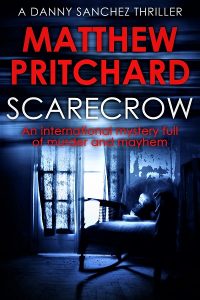
Need to know what happens next? Get Scarecrow now from Amazon.
Ellen Tyrell’s Nose and Other Suspicious Circumstances
With thanks to the British Newspaper Archive
I am looking for a drowned girl. My old friend, Professor Swaine Taylor will, no doubt, provide the grisly forensic detail in his Medical Jurisprudence: ‘the eyelids livid, and the pupils dilated; the mouth closed or half-open, the tongue swollen and congested … sometimes indented or even lacerated by the teeth …’
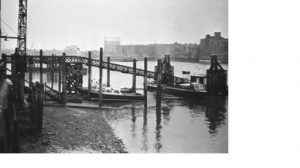
I need an inquest on said drowned girl; this is where the British Newspaper Archive comes in. There are drowned girls aplenty in London in the decade 1840-49. Poor things, dragged from the Thames, the Regent’s Canal, the Surrey Canal, the New River, the Serpentine, the lake in Regent’s Park, from under Waterloo Bridge – a favourite spot for those seduced and abandoned girls. There they lie stretched out on muddy shores and banks, their bonnets askew, one boot missing, or both, their faces pale like Millais’ Ophelia, or more likely, bloated and bruised, or half-eaten by decomposition – or rats. Their bodies sometimes float, buoyed up by petticoats – the effect of air retained by the clothes, or the presence of gases. Sometimes a thin hand grasps a clump of weed which, according to Professor Taylor, indicates that the victim went into the water alive. Did she fall or was she pushed? Suicide, most often.
I find the case of the suicide of two young sisters dragged from a Leeds canal in April 1847, tied together by a handkerchief. The handkerchief is pitiable somehow, and memorable. Dickens must have read of that case for he uses the same circumstance in Our Mutual Friend. Something of a thrill in contemplating that, but I need only one girl.
I need an unknown drowned girl, unclaimed, buried at the expense of the parish, and forgotten. Somewhere in a village, a mother wonders about her lost child. She will never know what became of her ruined darling. The Morning Post in February 1842 explains: ‘In London the bodies are taken to any obscure vault, public house, or police office. The Coroner directs the parish to advertise the body, often in vain.’
I find several cases of unidentified females in the newspaper archive. In July 1841, according to The Morning Advertiser, a young woman was pulled from the London Dock. She was never identified. I am intrigued by the report’s dark observation that ‘No one could walk into that water by accident.’ Unknown, too, is the identity of the ‘fine-made ’young woman taken from the Serpentine in October 1845 and deposited at St George’s Workhouse. Yet she has a distinctive mole on her left cheek, dark hair and hazel eyes. Surely somebody missed her. Seduced and abandoned, perhaps, like poor Eliza Luke found in the New River in April 1844.
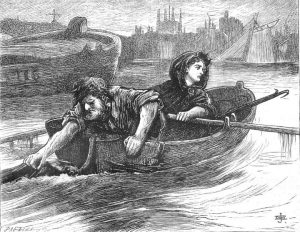
However, this is a crime story, so, naturally, I need a drowned, unknown, murdered girl. This is more difficult. Such is the damage done by the water, or the bridge, or the rocks of some lonely reach that it is often impossible to find enough evidence of murder. However, there is the case of Eliza Rayment found in the River Thames in October 1847. There is a deep cut under her chin. Four inches in length, an inch in depth, so reports Mr Bain, the surgeon, at the inquest, and there are ‘two arteries divided’. The wound might have been inflicted by the deceased, but ‘a person using the right hand would naturally make an incision on the left hand side.’ Eliza Rayment was right-handed. Mr Bain attributes death to the loss of blood from the wound. Poor Emma Ashburnham who was formerly Emma Meyer had once lived ‘in some splendour’ in York Road under the protection of ‘a gentleman of fortune’, but it is not known how she came to be in the river at Waterloo Bridge with a deep and ugly stab wound in her side.
Blood brings me to Ellen Tyrell and her nose. Ellen was found in the Surrey Canal in August 1845. Mr John Hawkins, the surgeon, finds an abrasion on the right side of the nose, but from the decomposition of the body he is unable to distinguish any other external marks of violence. Given that she was seen in the company of a man, not her husband, the night before she disappeared, the inquest is adjourned for the purpose of producing further evidence.
Oh, Eliza Rayment, what a mystery, what a suggestive tale, a married woman whose whereabouts were unknown for some days before your death. Who were you with? Emma, who was that ‘gentleman of fortune’? Alas, neither of you is for me, and Ellen, your nose, telling though it is, does not serve my purpose. I am ‘Oh, that I had been content with a cut throat, or a stabbing, but, in the interests of my plot, the victim must be strangled or I must rewrite the whole damned thing.
There is evidence I do like: the 1847 case of the unknown drowned young woman wearing a false plait at the back of her hair; the one in 1842 in which an umbrella is found nearby, bearing on its ivory handle the initials ‘F.H.’ And I like especially, the single earring she is wearing. I have a fancy for a single ruby like a drop of blood in my victim’s ear.
I dig deep into the newspaper archives and I find it – just the one, and the indefatigable Mr Bain is on hand to assist. The body was found in October 1848 near Battersea Bridge, much decomposed, appearing to have been in the water some time. Nevertheless, Mr Bain finds evidence of a ligature encircling the neck, though what this might have been he cannot say.
It is quite enough for me. Possible death by strangulation.
Oh, all right, I admit it: the body was that of a sailor. But, it did happen. Evidence of a ligature was found. I’ll just have to put an ‘s’ before the ‘he’. No one will know.
‘F.H.’? Names: Fanny? Florence? Flora? Ah, here’s a name in the archives: ‘Harvest’. I have her: Flora Harvest, the Grim Reaper cometh.
The Murder of Patience Brooke by J. C . Briggs

The Daily Mail and The Sun are both pretty shitty newspapers, I ought to know: I wrote for them both.
Why? Because they were the only newspapers that paid decent money to journalists working out of Spain.
Anyway, stories that were suitably comic, tragic or grotesque enough for The Mail or The Sun only occurred infrequently on my patch – but when they did, I entered an incredibly stressful, real life version of the cartoon, “Wacky Races”, as the first journalist to get there and get the pictures and facts, got the sale. The rest just wasted time and petrol, and I was always in competition with at least 3 or 4 others.

And it was those missed sales that started chipping away at my integrity. Because if you work for shitty newspapers, you very quickly begin to behave in a shitty way.

With me, it began with a bit of cheeky chicanery. Much of rural Spain consists of unmarked dirt tracks, the names of which are known only to locals, so most reporters rely on rural petrol station attendants for guidance, and I often slipped the staff a tenner to misdirect any other strangers asking around.
Pretty tame stuff, but it was the start of the road to Shitsville. And once you’re on it, the question quickly raises itself: How far down the road are you prepared to go?
I found out in 2010, when I covered a story about the collapse of a house which had killed two expats in a tiny hamlet way up in the mountains.
When I got there, I deployed my usual set of tricks. First of all, in order to find the house, I lied and said I was a friend of the dead couple and was there to pay my respects. This got me detailed directions, as well as plenty of pats on the back and commiseration from local Spaniards. I may even have squeezed out some crocodile tears for their benefit.

The property was all locked up and wrapped with police incident tape, so I climbed the fence and started looking for a decent angle from which to take a photograph, clambering, hopping and jumping all over the rubble as I did so. When a neighbour of the dead couple emerged and asked me what the hell I was doing, I ignored his question and asked him the only thing that interested me: ‘Have you seen any other reporters here before me?’
When he said, ‘No’, I climbed back over the fence and started looking for somewhere with Wi-Fi coverage.
I got the sale. But as I was celebrating in a local bar, looking through the photos I had taken, I began to notice that there was dried blood and other types of biological matter all over the collapsed concrete pillars and rubble. Then I noticed some of it had stained the tip of my desert boot as I’d been merrily desecrating a place where two people had died a sudden and likely very painful death.

I lay awake that night, and slowly came to the realisation that I did not have what it took to be a fulltime tabloid journalist. My journey along the road to Shitsville had ended.
And that’s where Danny Sanchez was born. Because Danny does have what it takes and I enjoy exploring the grottier side of journalism through the prism of the character.
Most readers warm to Danny immediately, but others don’t, and I suspect it is the ruthless side of Danny’s character that is the reason for this – he climbs walls, he lies, he goes through bins, he enters people’s homes uninvited and he “borrows” documents – in short, he does whatever he has to in order to get the story.
The trick is to make the people he is investigating so loathsome that the reader sympathises with Danny, despite his shady behaviour.
Anyway, for those of you who dislike the character, I’d ask that you cut the guy some slack – he trawls through the shitty side of journalism so I don’t have to.
Sapere Books are publishing books of mine from two different series involving two different detectives.
One, involving Lieutenant Josef Slonský is set in 21st century Prague; the other, featuring the university lecturer Master Mercurius, takes place in 17th century Netherlands. There are obvious differences in setting that inform the writing.
Slonský is a career policeman. He is inclined to take the occasional drink to get the mental cogs turning faster. There is nothing much in his life except his work, and since he is 58 when the series starts, the threat of retirement looms large. Slonský has all the support that modern science can offer, including a mobile telephone, though he does not really know how to do anything beyond making calls on it.
Mercurius is very much an amateur, an accidental detective who falls into the work when a series of abductions in Delft leave the local authorities baffled, so they send to the University at Leiden for a clever man who might help them solve these; and the Rector sends Mercurius. He is a young man, only 33, a lecturer in moral philosopher and an ordained minister, and he has little in the way of science to help him.
To my mind, though, none of these is the major difference between the series. I award that distinction to the fact that Slonský books are written in the third person, whereas Mercurius narrates his; and I thought it might be instructive to discuss why that is so.
I would love to say that it was the result of a carefully balanced decision, weighing all the factors for and against either approach, but if the truth be told the stories just came out that way. In my head, the action in Slonský appears as a film in which I stand back, observe, listen and record, whereas the Mercurius books involve me as a character in the tale I am telling. I toyed with telling Mercurius in the third person, but it didn’t feel right, and I have spent a bit of time thinking why that might be.
I think the reason is that Slonský is a big character, but he has a large regular supporting cast and it is important to me that we should get to know them. If he were also the narrator, I think he would dominate too much. Mercurius, on the other hand, is the only character who appears in all that series of books, and as the only consistent element the story has to pivot on him anyway.
This is not just of analytical interest. Many crime novelists consistently favour one or the other approach. I am prepared for either, but it changes the way the story develops. In Slonský stories things can happen when he isn’t around; Mercurius only knows what he sees and hears. That inevitably leads to a slower unwinding of the evidence, because it would seem forced if all the clues turned up in an afternoon. Slonský can send his colleagues out to investigate several lines of enquiry and bring them back together for a conference; Mercurius spends a lot of time travelling to discover things for himself. There is no telephone or telegraph system that he can use, and he does not possess a horse.
There have been rare examples of writers changing the voice during a series – Conan Doyle had Holmes writing one of his stories, for example – but generally once the choice is made, you’re stuck with it. It seems strange, given how important it is, that I am not more systematic in my selection!
LYING AND DYING, the first thriller in Graham‘s Slonský series, is available to pre-order now.
This is the first question for the crime writer, I’ve discovered. A tad macabre, but that’s the genre.
Hello there, victim, how would you like to die? I can strangle, bludgeon, knife or poison you, just for starters. But if that ain’t good enough, let’s be inventive. The sky’s the limit. The other day someone got mirrored to death in Midsomer Murders!
Problem is, the moment you decide how to kill someone, you’ve immediately got to find out what that’s going to do to their body. Enter medical research. That leads backwards to what your sleuth can and can’t notice and what it will tell her. She has to work out how it was done before she can figure out who dunnit.
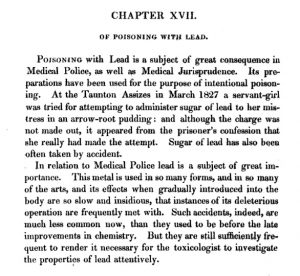 Just to complicate matters, when you set your crime in a historical context, you’ve got to find out what your medical man would have known at that time. Which isn’t what he knows now by a long chalk. At which point, thank heavens for the internet!
Just to complicate matters, when you set your crime in a historical context, you’ve got to find out what your medical man would have known at that time. Which isn’t what he knows now by a long chalk. At which point, thank heavens for the internet!
I turned up the most marvellous contemporary treatise on poisons on Google books, which tells me exactly what was known or thought about it, as well as how to recognise it, for every possible poison you could think of, and some you couldn’t. This was for the third book in my Lady Fan Mystery series. You can also dig up lots of accounts of horrific 18th century murders, which is extremely helpful, thank you, generating plenty of ideas.
There’s a strange satisfaction about killing victims off, I find. Does this mean I’m a closet murderer? Let’s be charitable, and say that it’s pure imagination and the writer’s mind. After all, I may kill them, but I’m also revenging their deaths and seeing that justice is done.
The other thing I’ve found is that you can’t avoid the inevitable exposition where your sleuth says how it was done. I’ve managed to steer clear of the cliché of gathering suspects together for the purpose, though, and tried to make it a natural part of the investigation process. But as a reader I wouldn’t be satisfied if the puzzle wasn’t somehow explained.
I don’t honestly think I’m going to spend too long worrying over the how-am-I-going-to-kill-you question. Ideas for future books seem to leap out at me with images of full-blown murders ready made. And the other common denominator? When I start writing the book, I haven’t a clue who dunnit or why. The fun of the genre is surprising myself with the answer.
It’s a truism that history is a set of facts left to posterity by the winners, and for historical novelists like me there’s always another ‘take’ on every so-called ‘fact’ we’re taught at school. A prime example of that is the enduring legend of ‘The Princes in the Tower’.
The first to get their stories organised were the Tudors who benefitted considerably from the unexplained disappearance from the Tower of London of the Yorkist royal heirs Edward, Prince of Wales, and Richard, Duke of York. 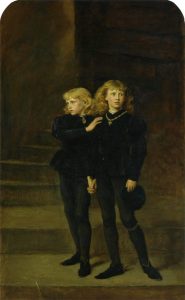
When Henry Tudor defeated Richard of Gloucester in an obscure field in Leicestershire we now know as ‘Bosworth’ (even though that town didn’t exist then), there was no one left on the Yorkist side to challenge his claim to the throne, given that the princes were no more. But it was essential to point the finger away from ‘the person most likely’ – the obvious suspect for the disappearances/deaths, and the Tudor propaganda machine swung into action.
Sir Thomas More possible lived to regret the assistance he gave to Henry VIII in perpetuating the myth that the person behind the disappearances of the princes from the Tower had been a close relative of theirs, namely their uncle. But More was the first to point the written finger at Richard of Gloucester, particularly after Sir William Tyrell, during the reign of Henry Tudor, allegedly confessed to having done the job in the pay of Richard. But tortured men will eventually say whatever their torturers want to hear, and the alleged confession came, second hand, through the mouth of the torturer.
 Never one to miss an opportunity to ingratiate himself with a royal patron, that literary prostitute William Shakespeare built Thomas More’s accusation into a horror story of a crook-backed, slew-footed, psychopathic freak who did away with anyone who stood between him and the throne. Actors such as Laurence Olivier and Benedict Cumberbatch then provided us all with a visual image to go with the verbal hype. The net result of all this ‘fake news’ was that we all grew up believing that Richard III had done for the two little boys under his guardianship.
Never one to miss an opportunity to ingratiate himself with a royal patron, that literary prostitute William Shakespeare built Thomas More’s accusation into a horror story of a crook-backed, slew-footed, psychopathic freak who did away with anyone who stood between him and the throne. Actors such as Laurence Olivier and Benedict Cumberbatch then provided us all with a visual image to go with the verbal hype. The net result of all this ‘fake news’ was that we all grew up believing that Richard III had done for the two little boys under his guardianship.
But spin the wheel 180 degrees, and there was someone else who benefitted equally from a sudden absence of Yorkist claimants to the English throne. He had an alibi, of course, because at the most likely date of the crime – the Summer of 1483 – he, Henry Tudor, was in exile in Britanny.
But back home in England, ‘Mummy’, the formidable, wily, scheming Margaret Beaufort, was preparing the runway for her favourite son’s safe landing with an invasion force. She also had a useful second son – Henry’s half-brother the Duke of Buckingham – who was Lord High Constable of England, with responsibilities that included security at the Tower of London. Go figure, as they say.
Having written a novel from the Tudor perspective (The Flowering of the Tudor Rose), and having suffered death by blog from dedicated ‘Ricardians’, I took up the case for the defence in Justice for the Cardinal, due for publication by Sapere Books later this year. The central character in this novel is Richard Ashton, grandson of the Duke of York who escaped from the Tower, only to be executed under his assumed name of ‘Perkin Warbeck’ by a paranoid Henry VII.
‘You pays your money . . . .’, as the old saying goes. The jury will forever remain out on who really ordered the murder of the princes. In the meantime, we historical novelists can play on both halves of the pitch.
I began my writing career many moons ago when I was studying medicine at the University of Dundee in Scotland. At that time the city was famous for the ‘three J’s’ of Jute, Jam and Journalism. Journalism referred to the publishing firm of D C Thomson, which produced the famous Beano comic and countless other publications.
I submitted a few children’s stories to the People’s Friend, a well known family magazine that is still going strong today. To my surprise and delight they were accepted and I was soon regularly writing stories for the Children’s Corner on the inside back page. 
Then once I had graduated I moved to Hull. While I was working in cardiology I learned that the Kingston-upon-Hull telephone exchange had a ‘dial-a-bedtime’ story service. For the cost of a phone call parents could have a short three-minute bedtime story told to their youngsters over the phone. My stories were soon being recorded and heard by youngsters all over the city.
Inevitably, I longed to have my name on the spine of an actual book. It was then that I came across that old adage, ‘write about what you know.’ It is one of the nuggets of writing wisdom, except it is often misinterpreted.
In my case as a medical doctor I assumed that it mean that I should write a medical thriller or maybe a medical romance. My problem was that I worked in medicine and didn’t want to spend my thinking and writing time in medicine as well. So I had several false starts on various non-medical novels, and like most writers I have a drawer full of opening chapters for several books that never saw the light.
Then it dawned on me. It didn’t mean that I had to write exclusively about a medical world, but that I should use my medical knowledge to really make a character stand out and be believable. Or I should be able to drip in details about drugs, operations, or snippets of medical history, to give the work authenticity. And that is just what I did in my first western novel Raw Deal at Pasco Springs. I did the same with several other westerns before turning to crime!
I began by creating West Uist, an island in the Outer Hebrides of Scotland and peopled it with believable characters, including the local doctor, who doubles as a police surgeon. On the island my detective, Inspector Torquil McKinnon can solve crimes using his brains rather than depending upon forensic science and DNA. Yet in The Gathering Murders, the first novel in the series there is still plenty of medicine peppering the plot.
Crossing one genre gives you the confidence to do it again. The bridge that I use is medicine. I am able to create believable medical situations. For example, I write collaborative western novels with some other writers in the USA. We have created a town called Wolf Creek and each collaborator writes one or two chapters per novel from the viewpoint of his or her character.
My character is Dr Logan Munro the town doctor, who extracts bullets, sets broken bones and delivers babies. Similarly, I use my knowledge of the history of medicine in my historical novels, The Pardoner’s Crime and The Fool’s Folly, which are set in the thirteenth and fourteenth centuries.
Essentially, my message is that you don’t have to set your story in your relevant world. What you can do is drop in a character that shows your expertise. That is my interpretation of the axiom ‘write about what you know.’


